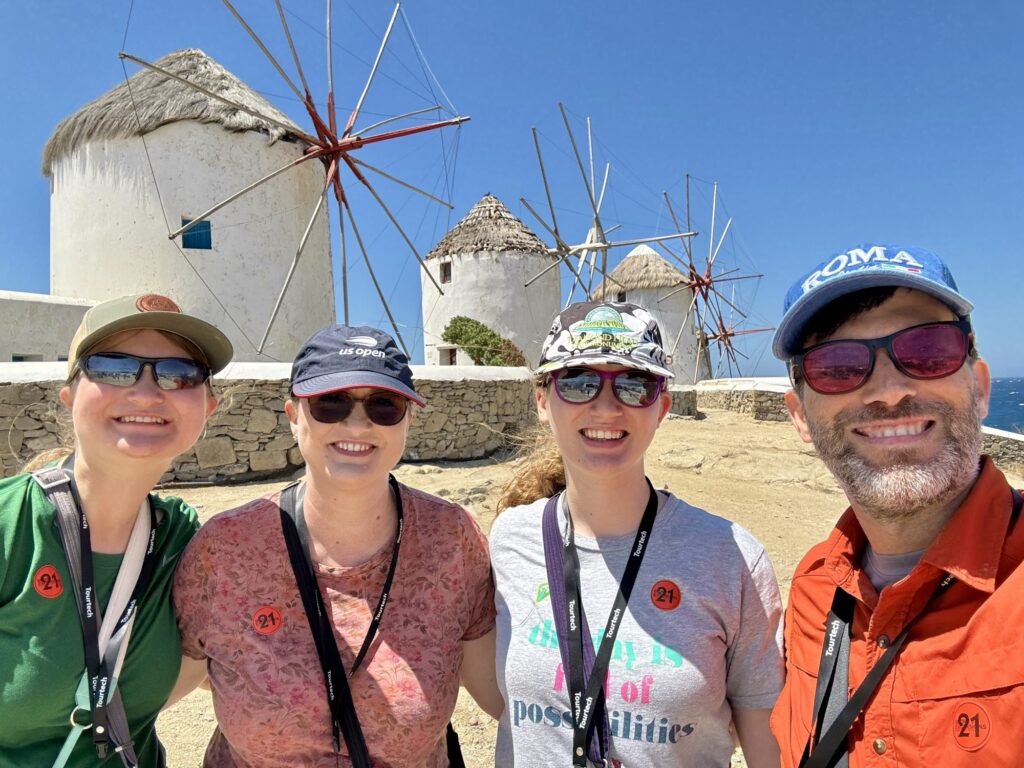
We sailed into the Greek island of Mykonos early this morning and our wake up was before 6am the get ready for our tour that met at 7:15 AM.
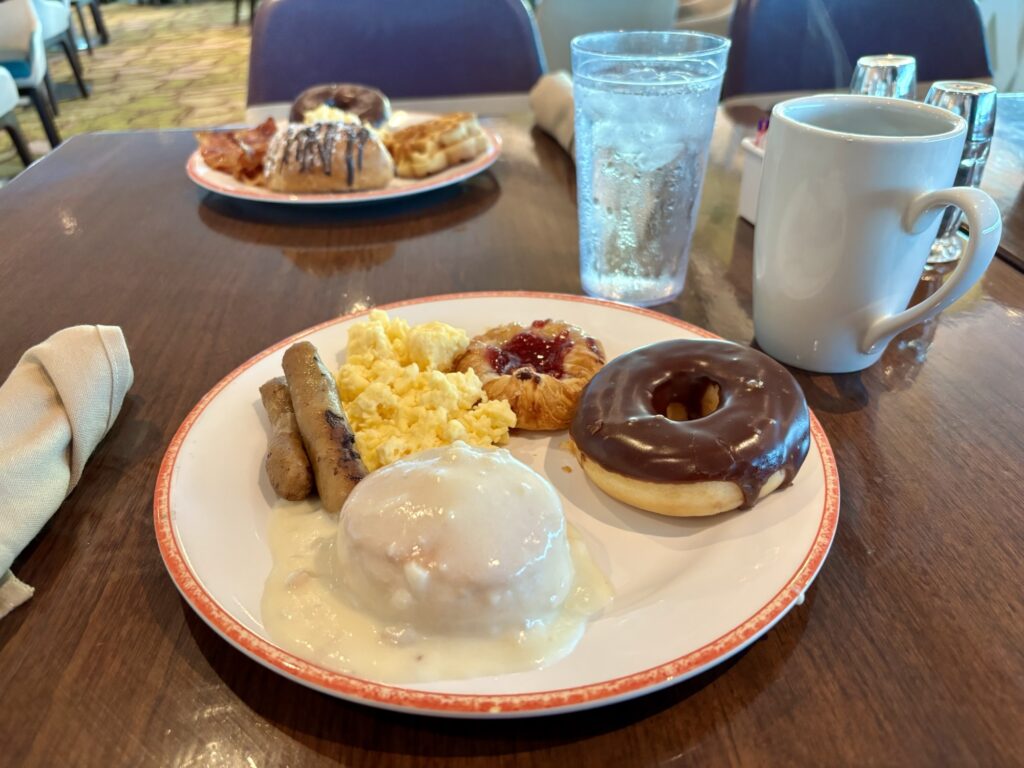
Because of the early start, we had breakfast in windjammer, which was yummy as always. I especially enjoyed the chocolate donut.
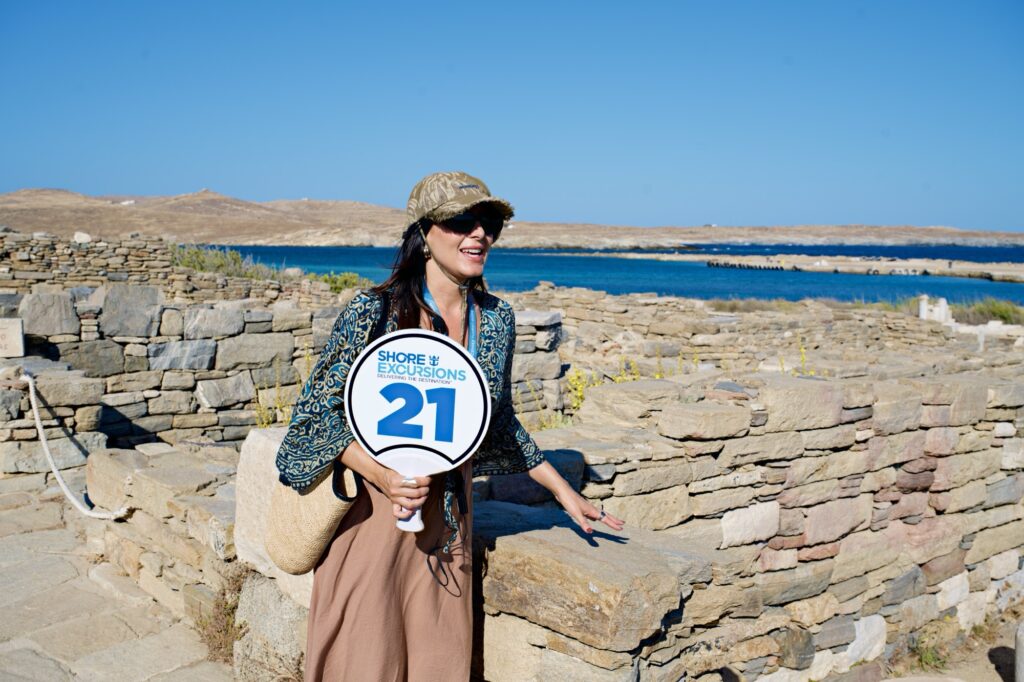
After breakfast we met in the Royal Theater for our tour and were assigned to group 28. From there we disembarked on deck one and soon met our guide Sofia.
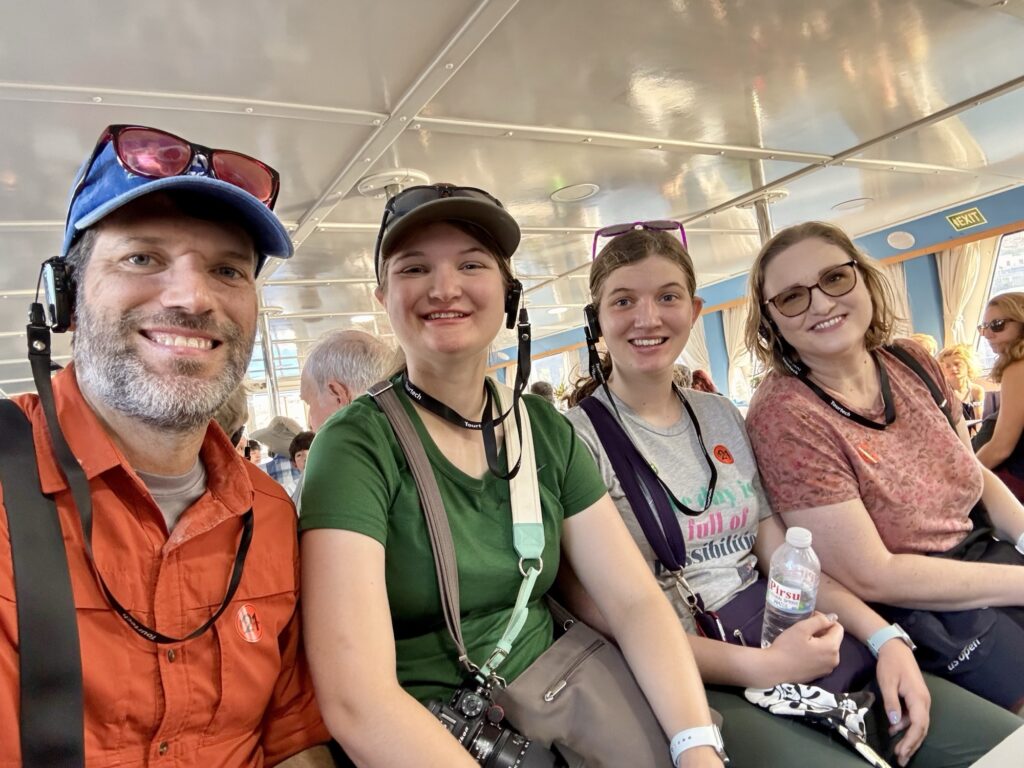
Our first stop for the day was the island of Delos, and Sofia led us to the Mykonos Riviera Ferry boat for our ride to the island. The Aegean was pretty rough, which made for a bumpy, 45 minute ride to Delos. I was worried that one of us would get sick but we all came through ok.
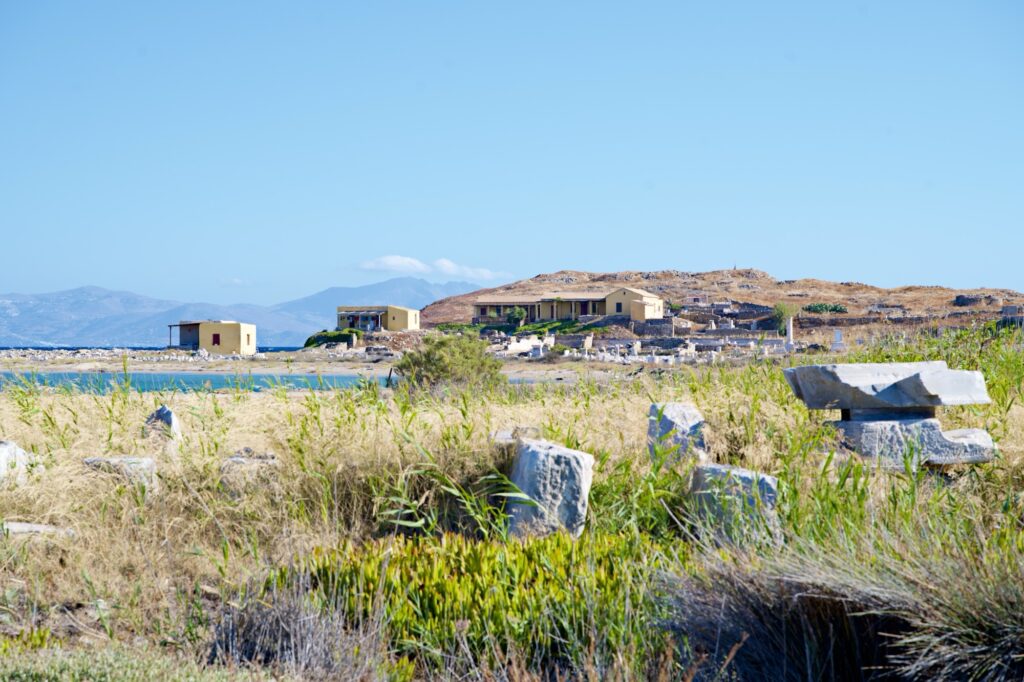
At the island, it very windy, but the conditions were relatively comfortable. Sofia explained that Delos island is the largest archaeological site in Greece. As a matter of fact the entire island is a protected site. Only two types of people live here, archaeologists and guards who reside in small yellow houses on the island.
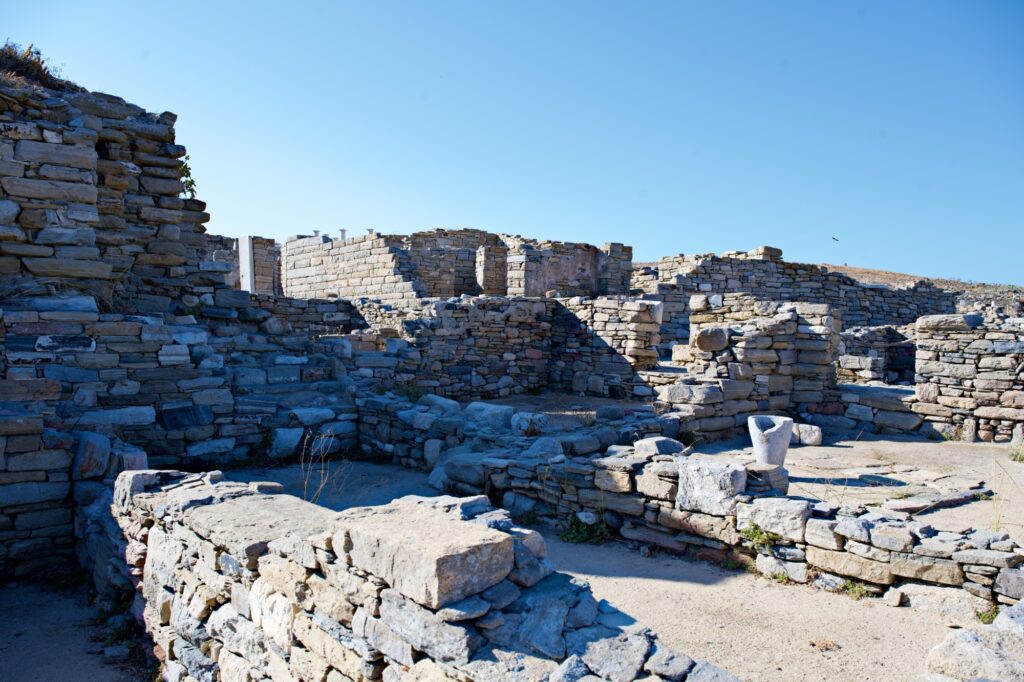
Our first stop was the theatre district which dates back to the Hellenistic Period (approximately 3rd century BC). As we were walking toward the theater district, Sofia explained that all of the Cycladic islands (including Mykonos and Santorini) circle around Delos. The word Cycladic means “circle”.
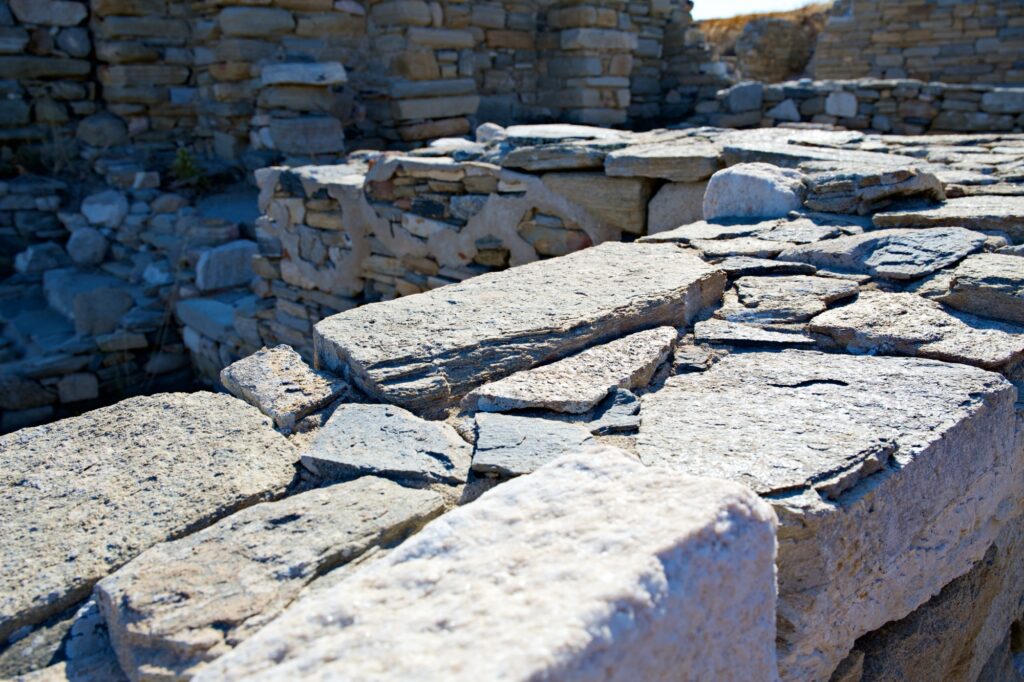
In the theater district, we say the remains of many buildings. Sofia pointed out that all of the buildings on Delos and made of granite and marble. The granite comes from the Cycladic islands like Mykonos and Delos. We saw lots of natural granite formations in Mykonos later in the day. The marble came from other nearby islands.
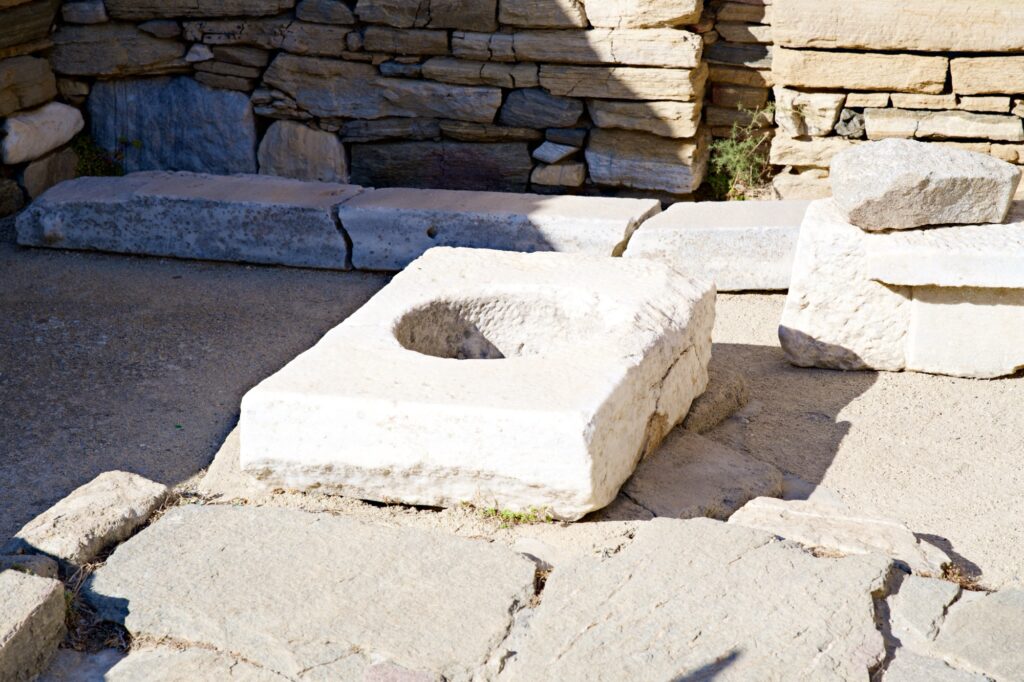
One of the first things we saw was a house with a marble well in the floor. The well still contains water and I was able to look in and see my reflection.
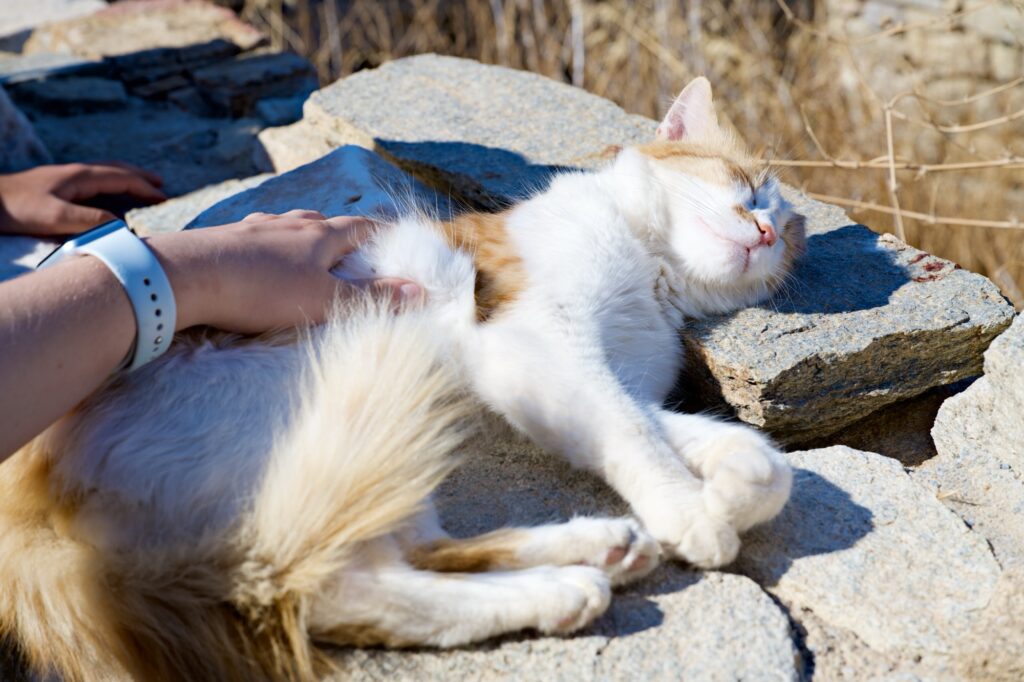
The whole time we were on Delos we saw lots of cats. Sofia said there are over 200 cats on Delos and they are fed by the guards twice per day. Unlike most feral cats, these really wanted to be petted.
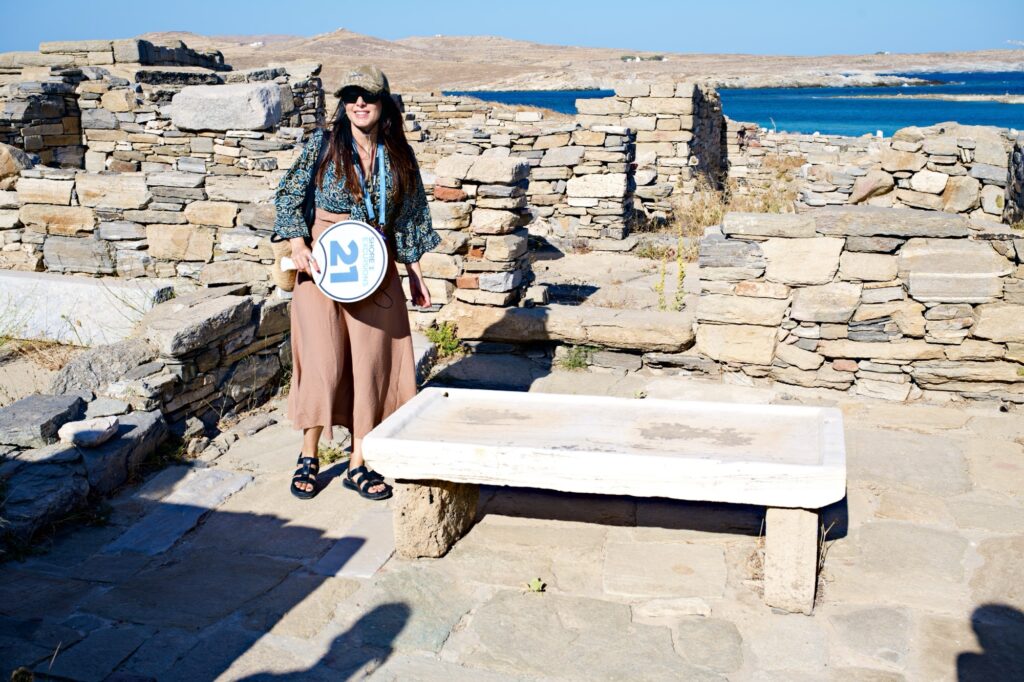
Next we saw was believed to be a shop with a marble bench.
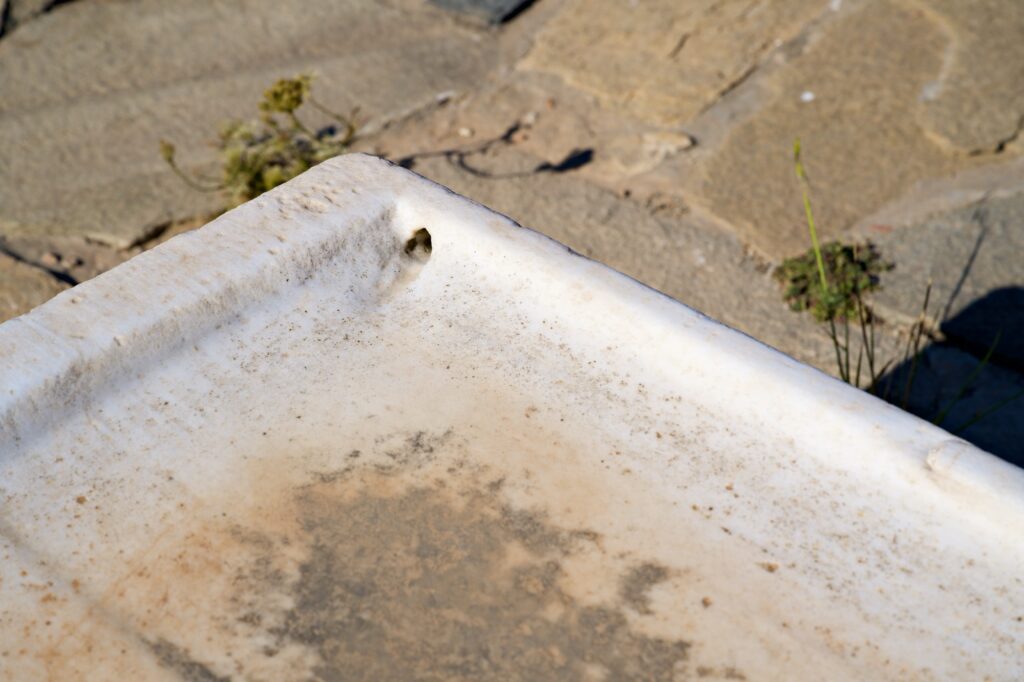
The edge of this bench has a small hole, so they think this was a fish marker with the hole to drain the water.
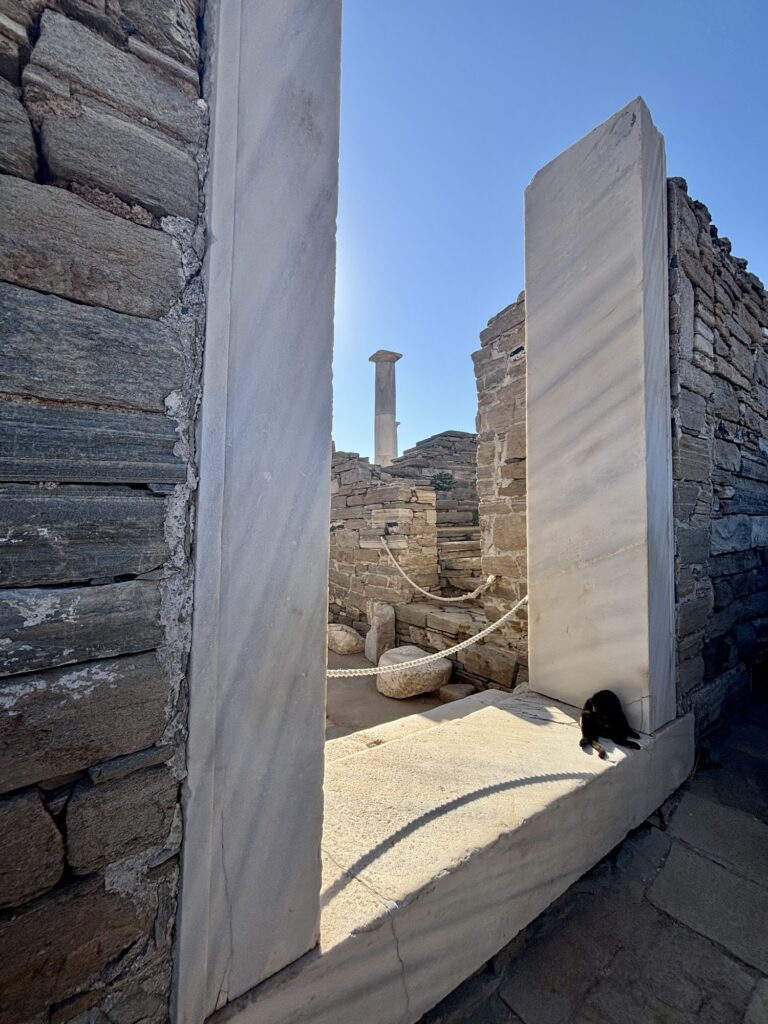
From there we went to the House of Dionysus, which was a massive home with 16 rooms and a marble entrance.
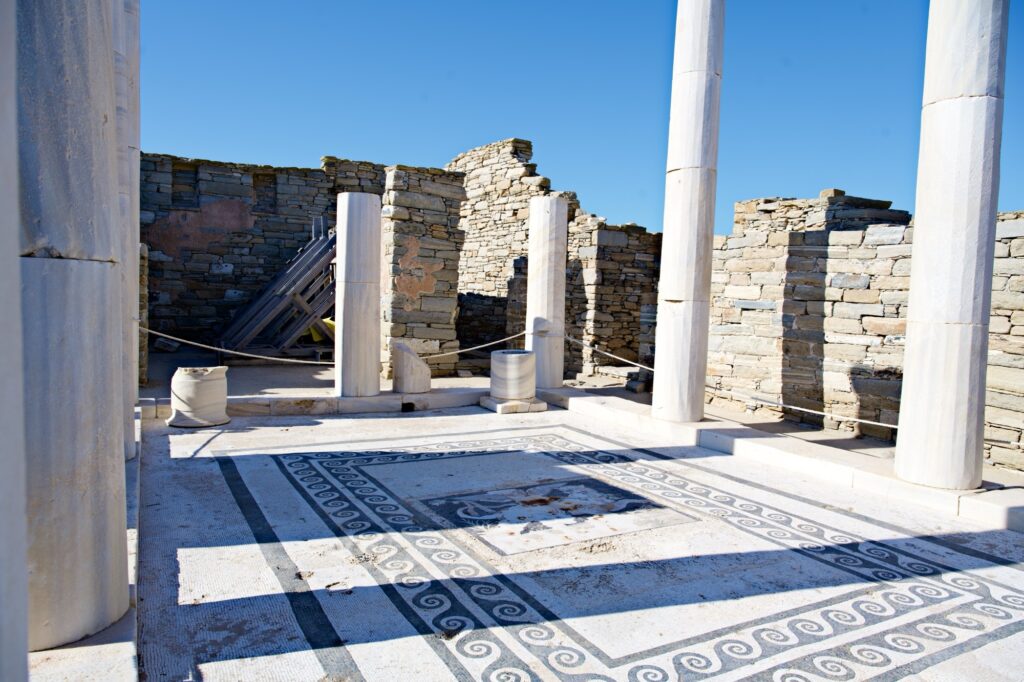
In the center of the house is a column lined courtyard with a beautiful mosaic floor. In the center of Mosaic is Dionysus (god of wine, entertainment, and theater) and a tiger. This is the reason why it is called the House of Dionysus. Interestingly, there is a Dionysus house in ancient Zippori (Sephoris) in Israel. It is named after Dionysus for the same reason.
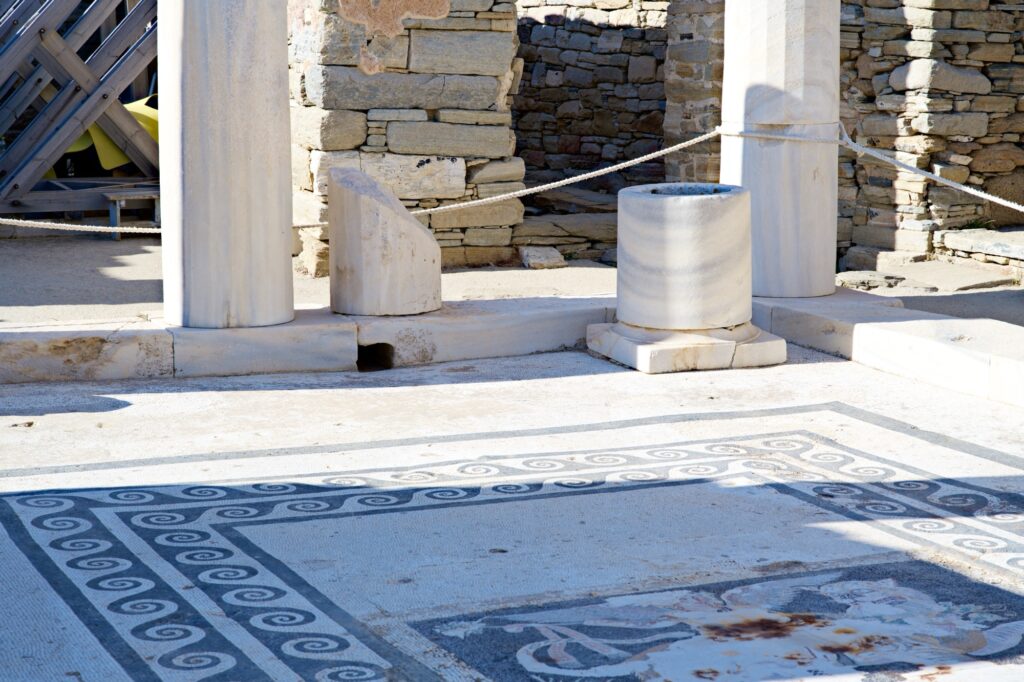
On the edge of the floor was a hole that Sofia said connected to an underground cistern. The courtyard was used to collect rainwater. There was also a column shaped “well” beside the hole for collecting water.
Sofia also pointed out that there were no windows on the first floor. This was likely due to the presence of a sewer system on the main road where the House of Dionysus was located. Instead the courtyard was open to bring fresh air and light from the top. There likely would have been a covering for the heat of the summer months.
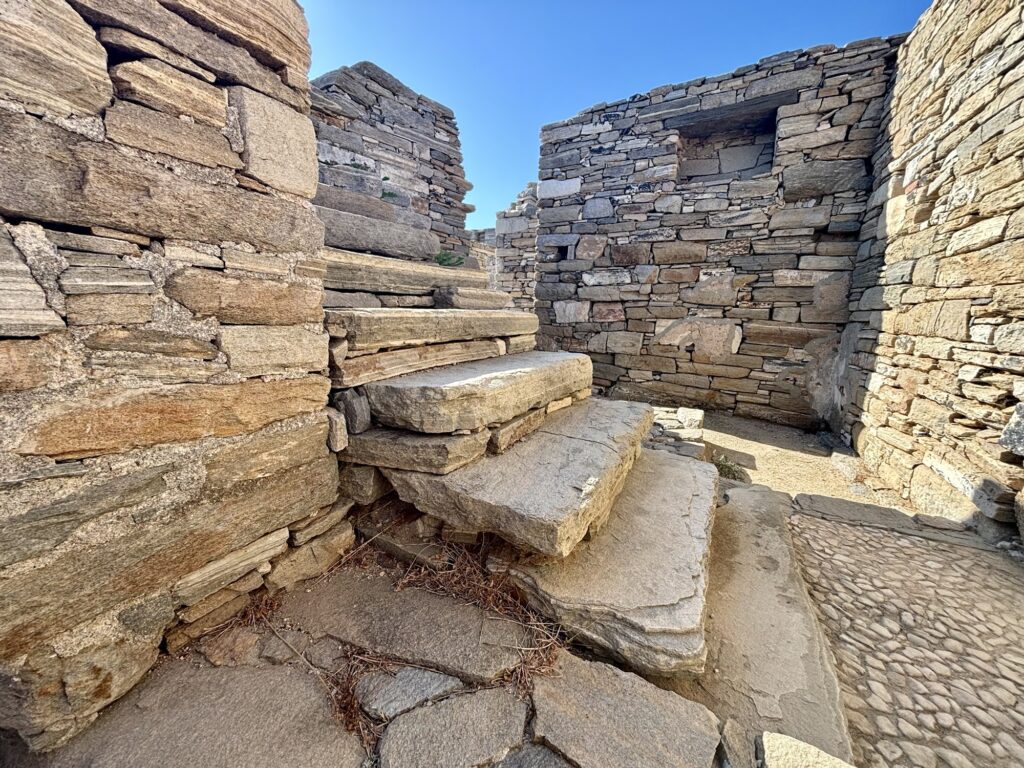
We also saw some stairs that led to the second floor and paint remaining on the walls from ancient frescoes.
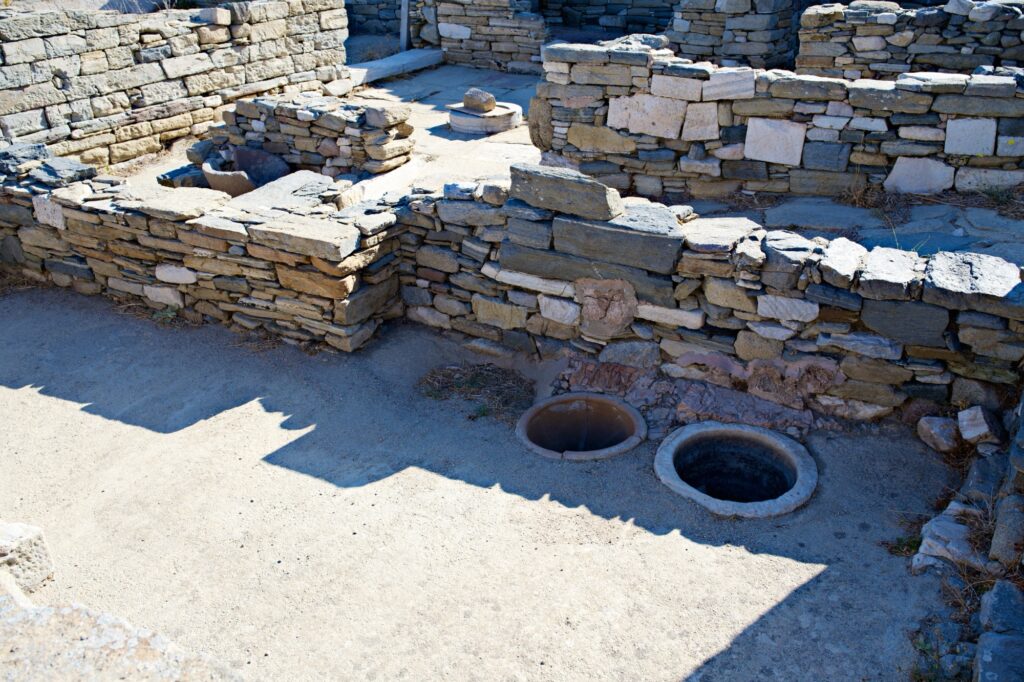
After leaving the House of Dionysus, Sofia took us to a small home with containers in the floor. She said these were used for storing and preserving liquids and food. Because they were underground, it would be cooler, like a refrigerator.
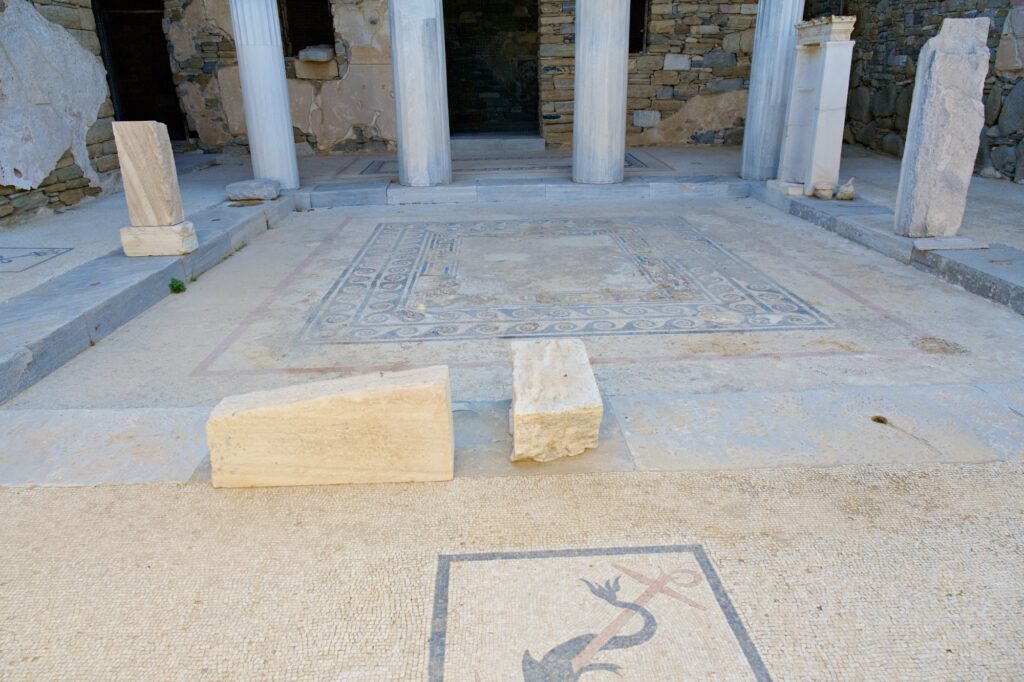
We saw another lager house called House of the Trident. This name comes from a very large mosaic floor with a trident pictured. Sofia said these floors were made of cut stone that was not painted. The colors come from the stones themselves.
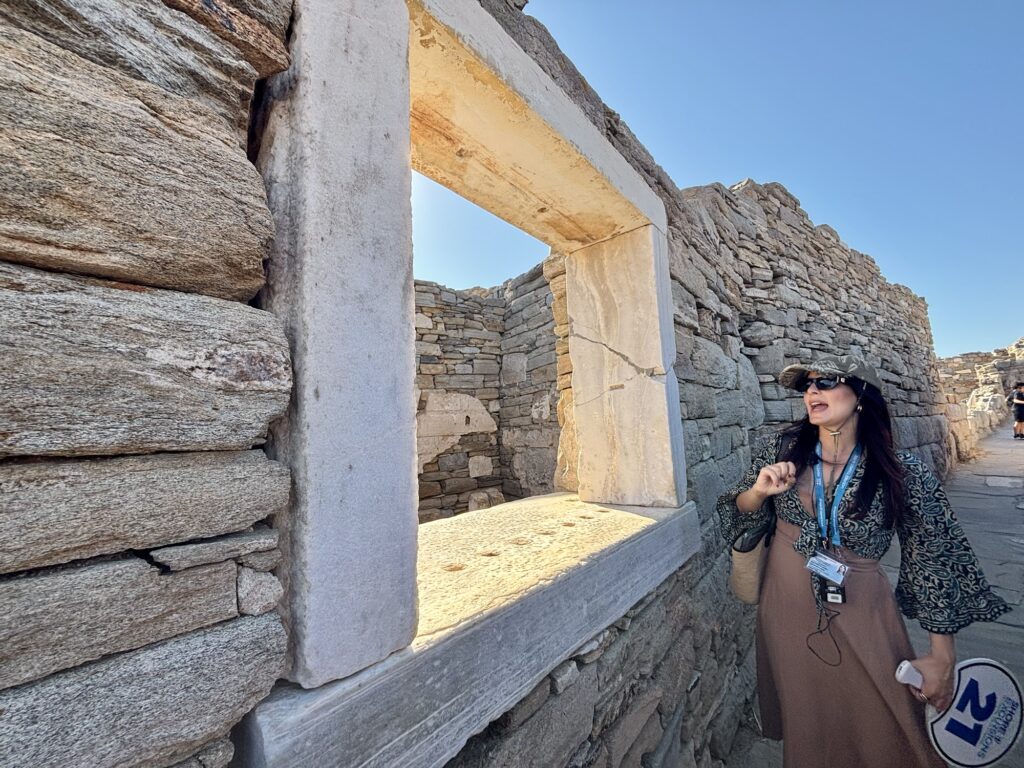
Unlike the House of Dionysus, the House of the Trident did have a window facing the main street.
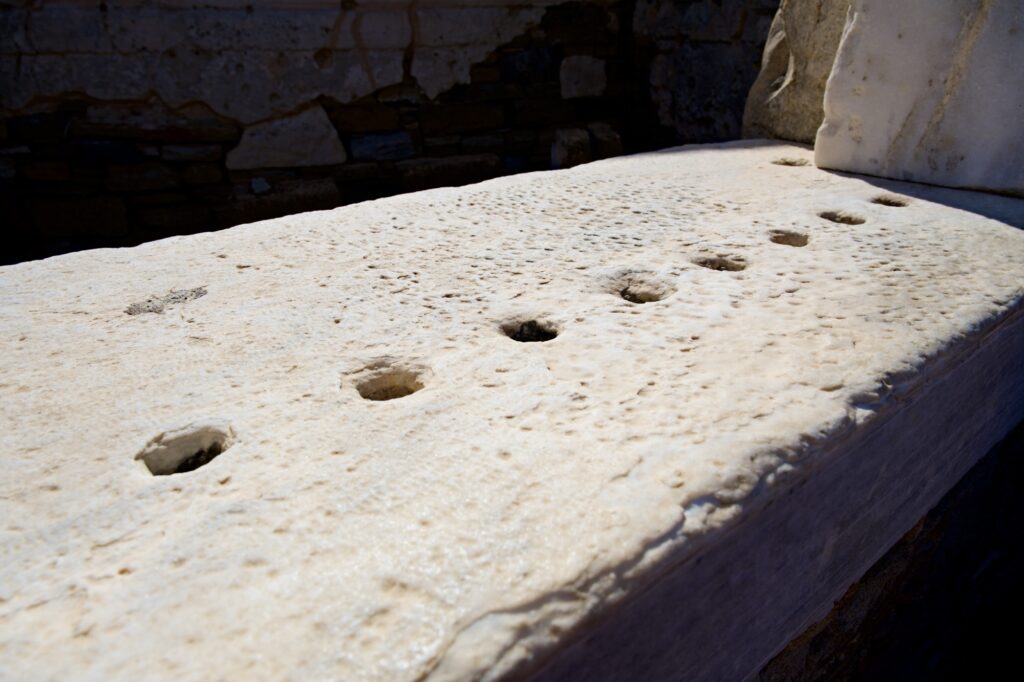
Archaeologists have surmised that this family was in banking because the window originally had bars as evidenced by the holes in the marble.
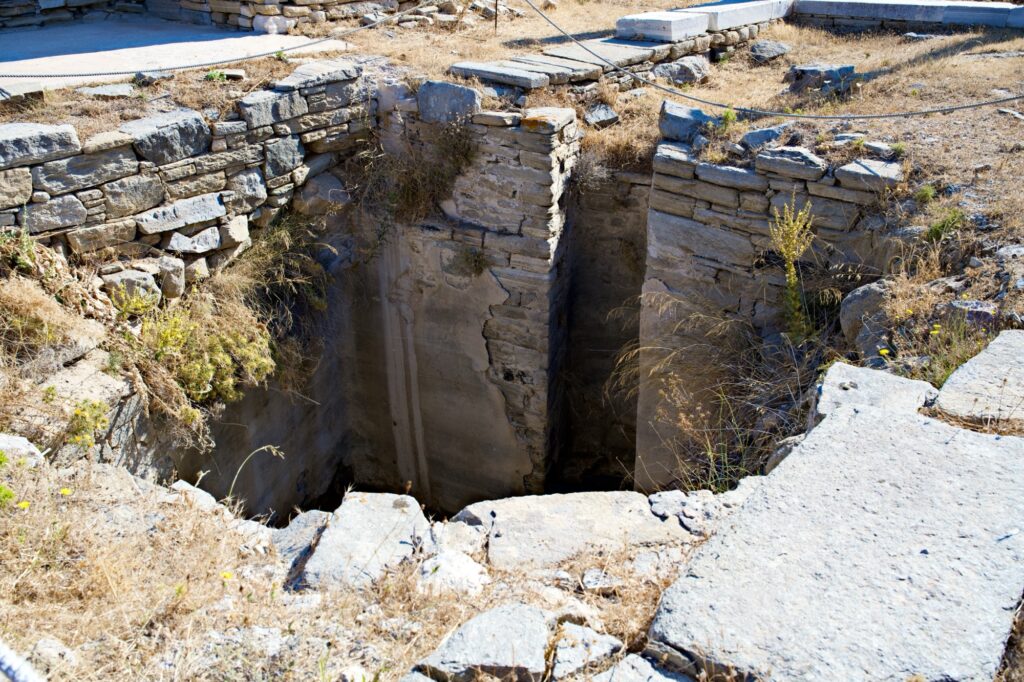
We saw another house where the first floor had collapsed revealing the cistern underneath. Sofia said that many families in Delos had private cisterns, but there were also public ones as we would see later.
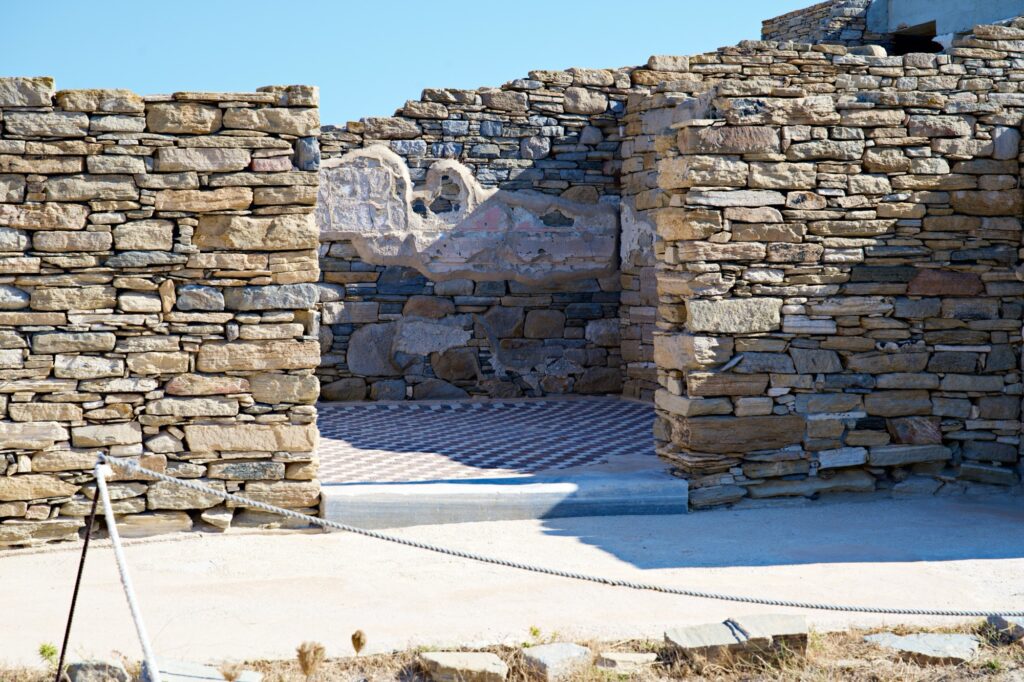
From the same spot we could see inside another house with a beautiful geometric mosaic floor. Sofia said this was due to give an optical illusion that the room is bigger.
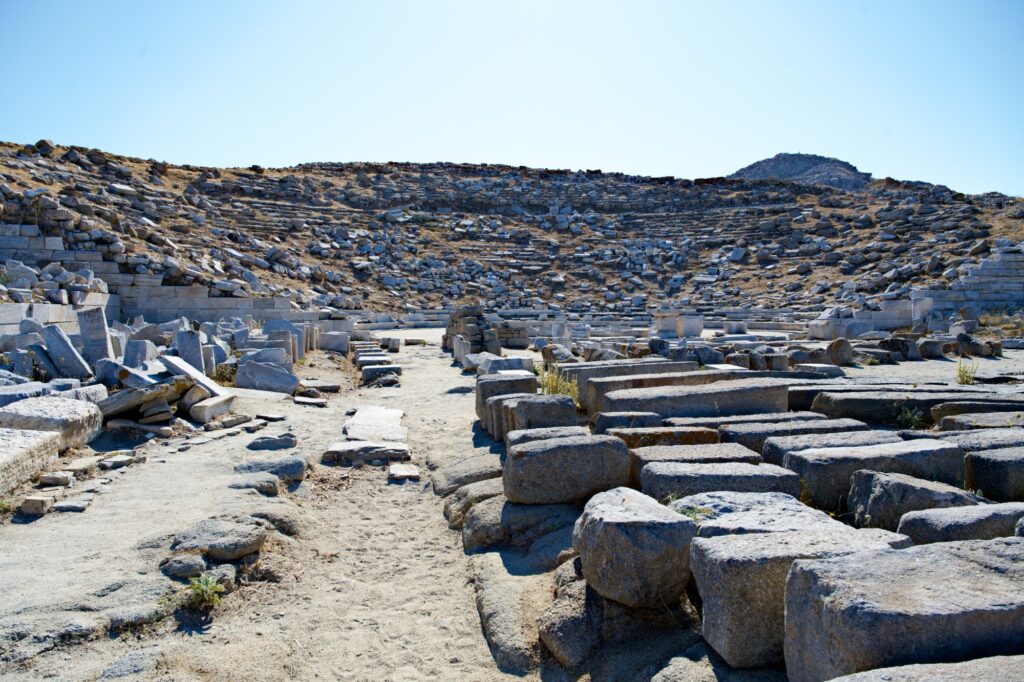
Next we reached the Greek Theatre for which this district is named. This theater would have held approximately 6,500 people.
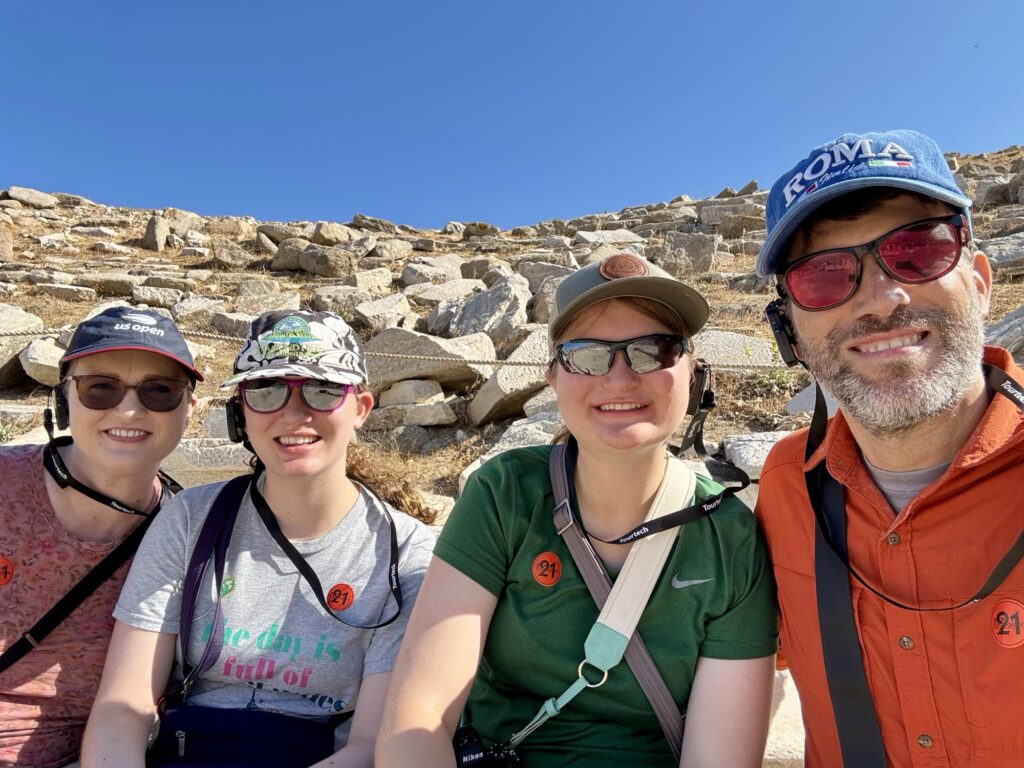
Sofia had us the group sit in the front row of seats, which were made of marble and had backs. She said that much like in today’s theaters and arenas, these were the “VIP” seats.
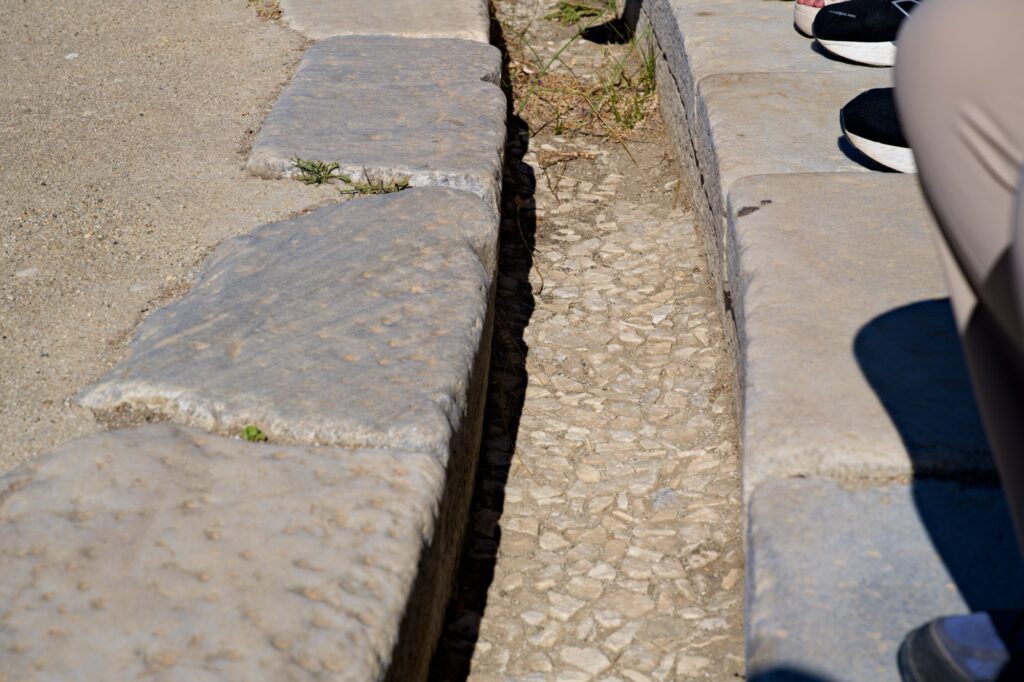
In front of these seats was a trench that was used for collecting rainwater.
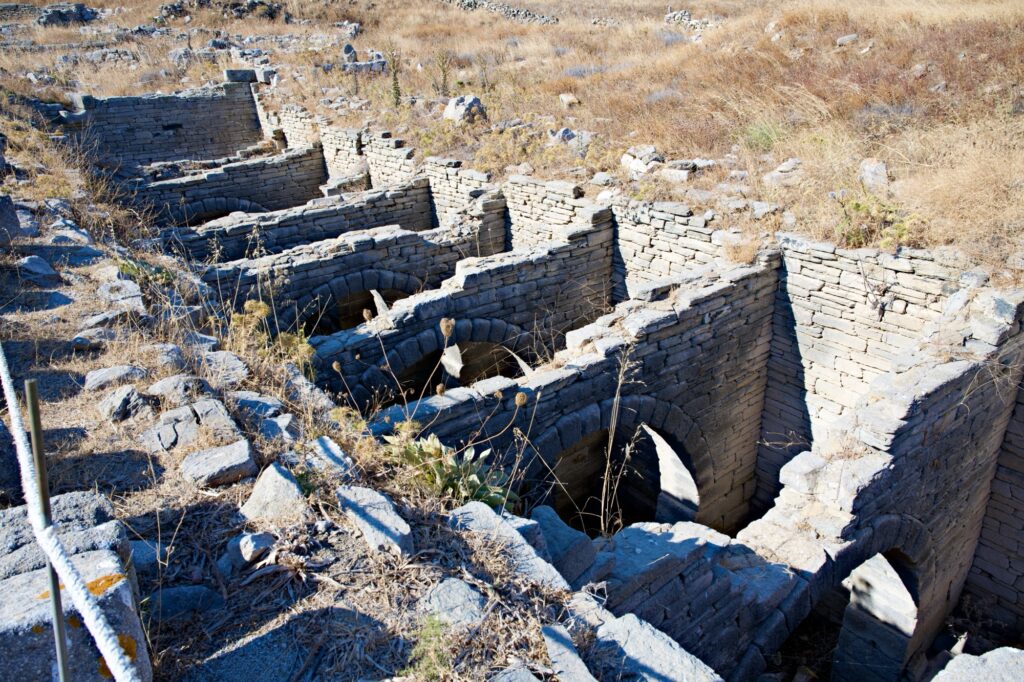
This rainwater would have flowed into an arched public cistern below the theatre.
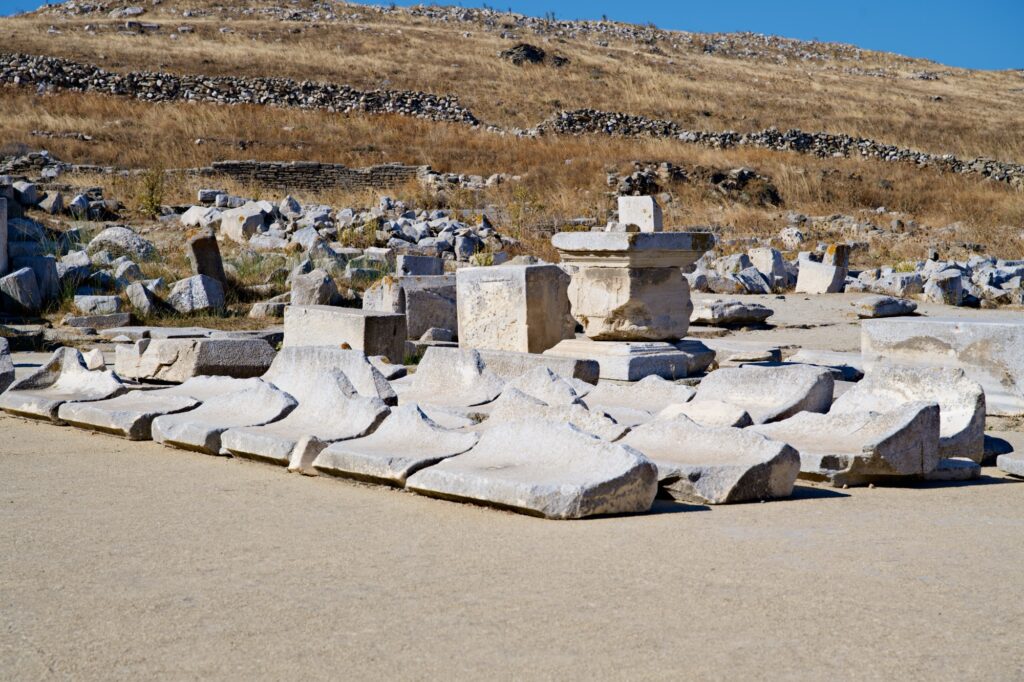
At the front of the “orchestra” in the theatre were the remains of an altar. Sofia said that in a Greek theatre, performances would begin with the sacrifice of a male goat to Dionysus. The word for the sacrifice of the goat is the word from which we get our word “tragedy”.
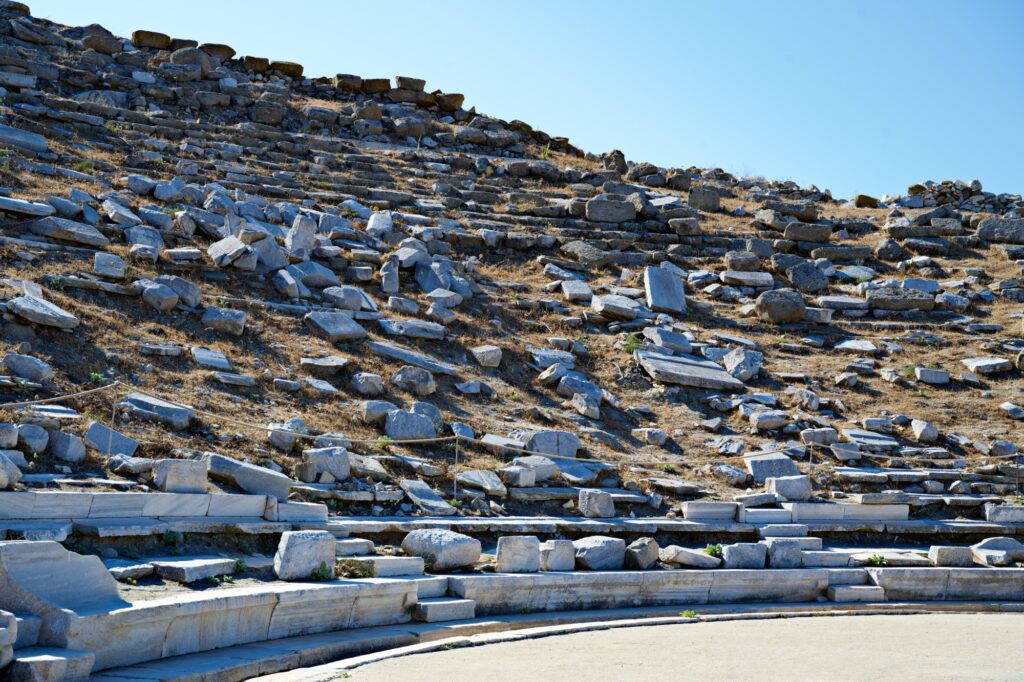
The performances would consist of tragedies, comedies, or satires that were often offering political commentary. The actors were all male and were called “hypocrites” (pretending to be someone you are not). One of the major differences in the transition to the Roman period is that performances were for pure entertainment.
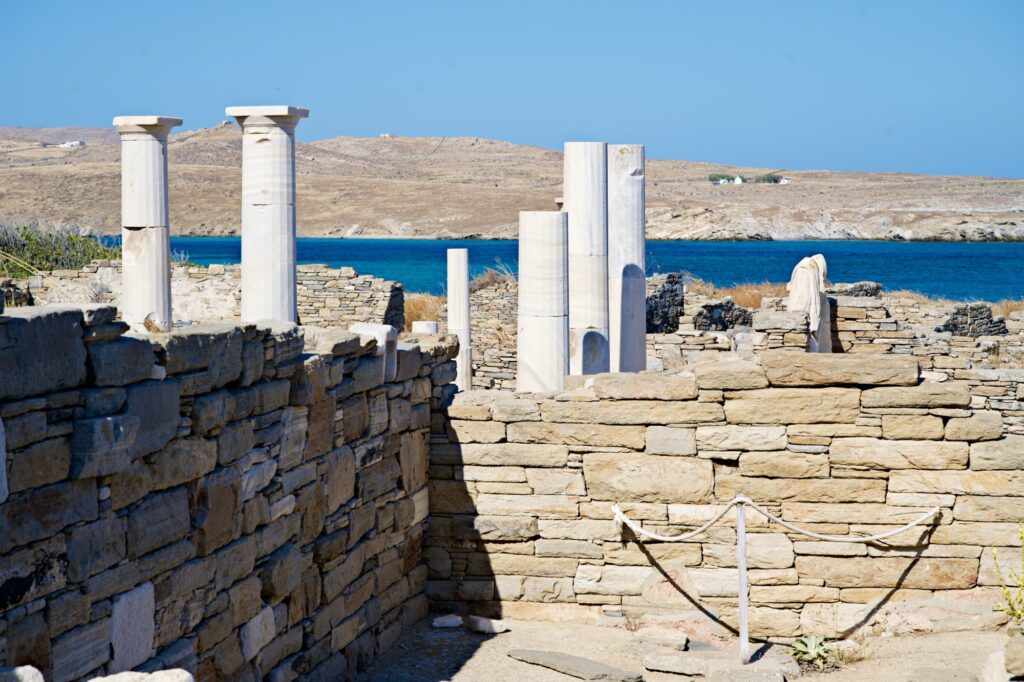
On the way out of the theatre district, we saw a home with two headless statues. This is know of as the House of Cleopatra because of the inscription on the statues (not the “Cleopatra” of Egypt”. This was the largest house on Delos and would have had an amazing view.
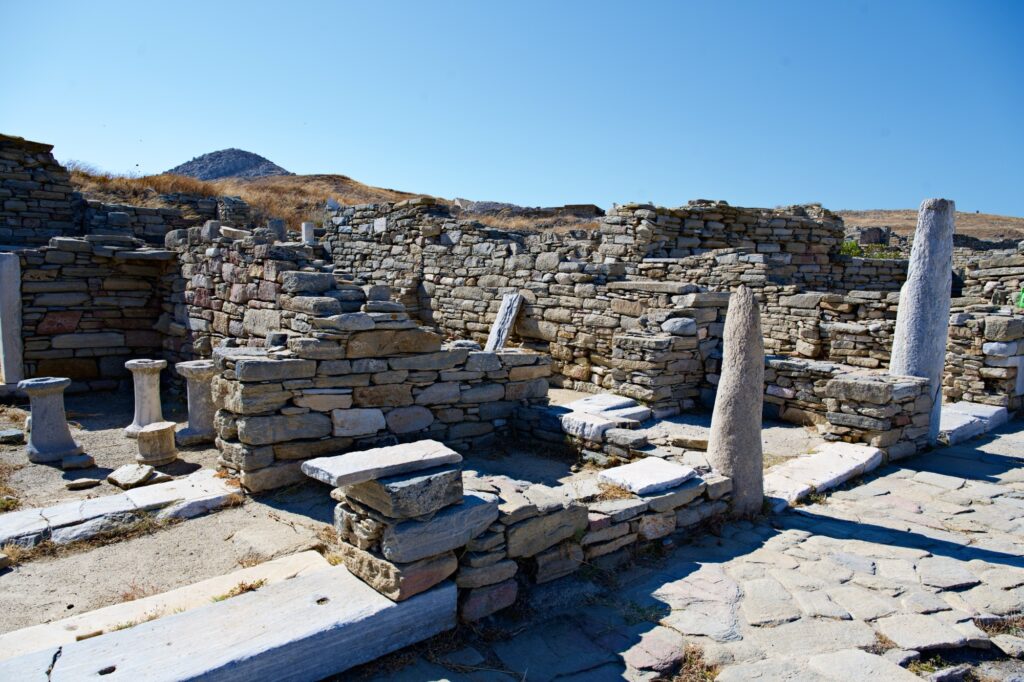
Next, we walked to the Market side of the town. Sofia explained that when the Romans claimed Delos, they made it a tax free port. At its peak it had 30,000 residents and 3,000 shops. It became a place where representatives from many nations would come to meet. Sofia described it as being like an ancient NATO.
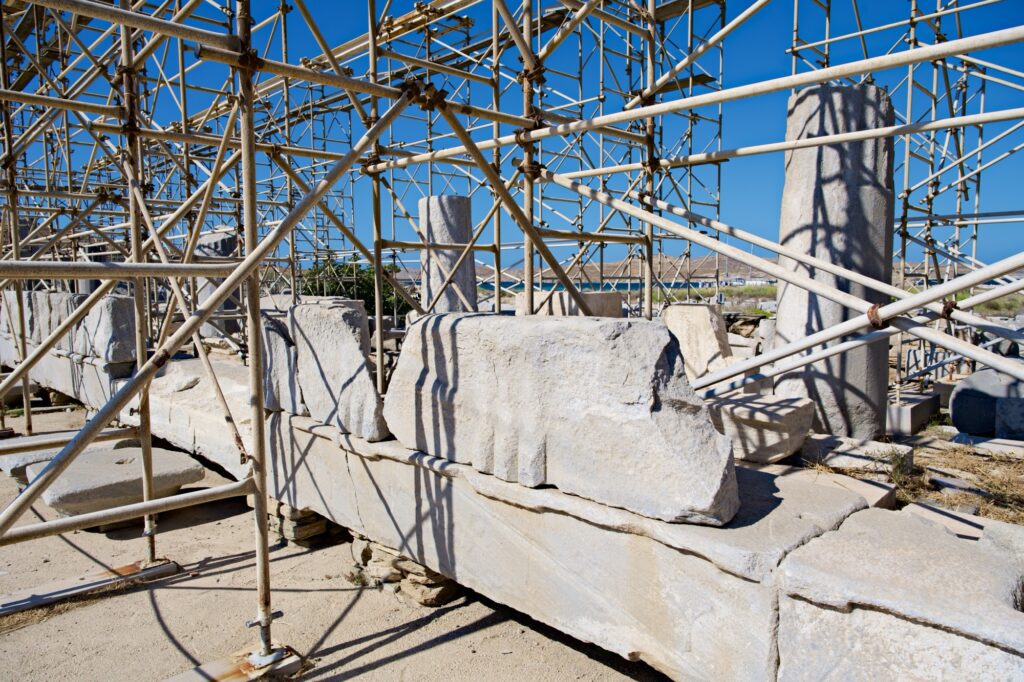
We began to walk up the “Holy Way” to a number of temples dedicated to Apollo. This island is the legendary birthplace of Apollo. The first thing we saw was a massive columned portico from the Hellenistic period this is being restored. This portico was dedicated to Apollo and would have been filled with many shops. It is known as the Portico of Philip V (not the father of Alexander the Great) due to inscriptions found in the building. The portico faced away from the sea to protect the buyer and seller from the weather.
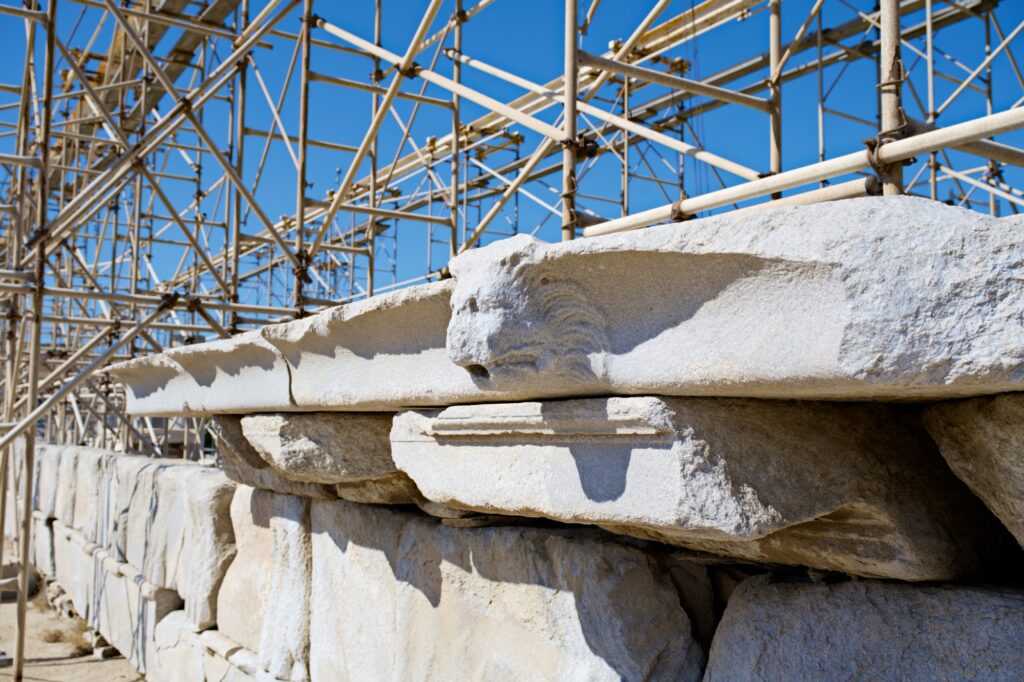
Sofia pointed out a marble section of the roofline that has been recovered. It has the head of a lion that was used for drainage like a modern day downspout.
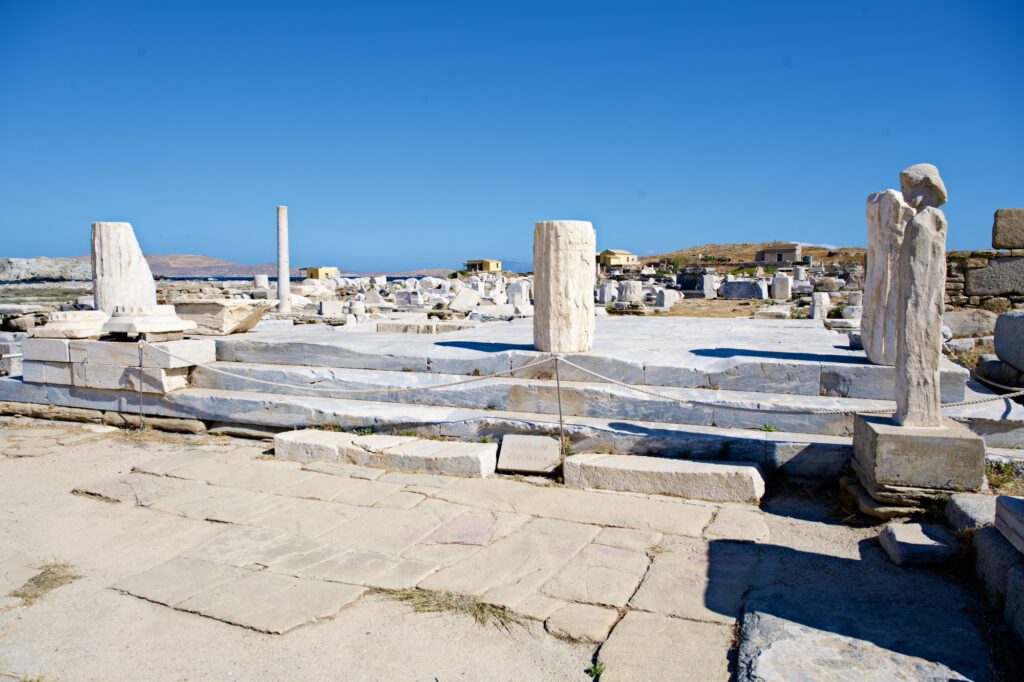
From there we walked to the entrance to the Temple of Apollo, which was one of four temples dedicated to Apollo we saw on Delos. Two of these were from the archaic period (7th-6th century BC) and two from the classic period (5th century BC). One of the ones from the classic period was never finished.

Around these temples we saw several square marble posts topped with the head of Artemis. Sofia said these were marking important points in Delos.
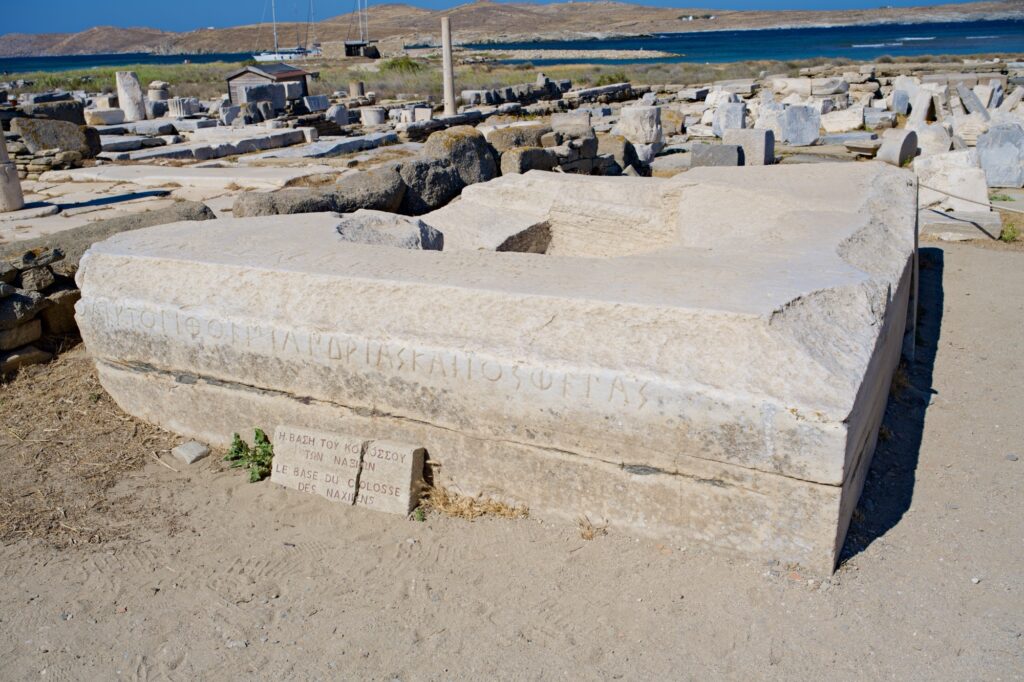
During the archaic period, the island would have been occupied by the Naxians. They built a statue of Apollo that was nine meters tall outside of one of the temples. This statue was known as the Colossus of the Naxians.
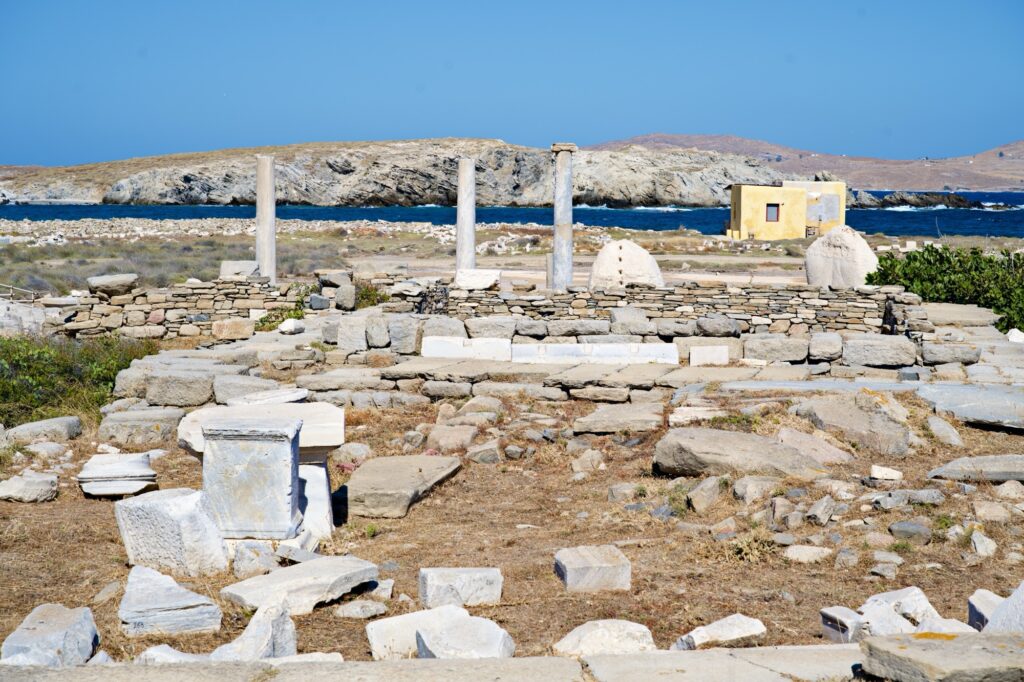
There are a few pieces of this statue remaining. We saw two that are on the island and others are in museums. We also saw the excavated base of this giant statue.
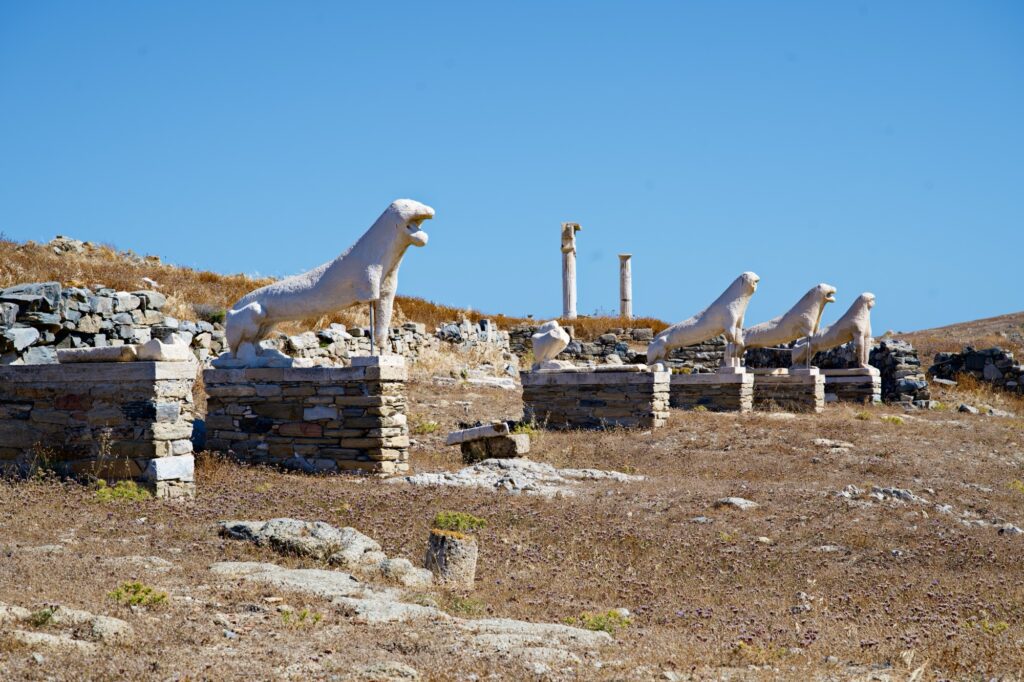
Our final stop was the Terrace of the Lions. This originally consisted of 16 lion statues made of Naxian marble overlooking the legendary spot where Apollo was born.
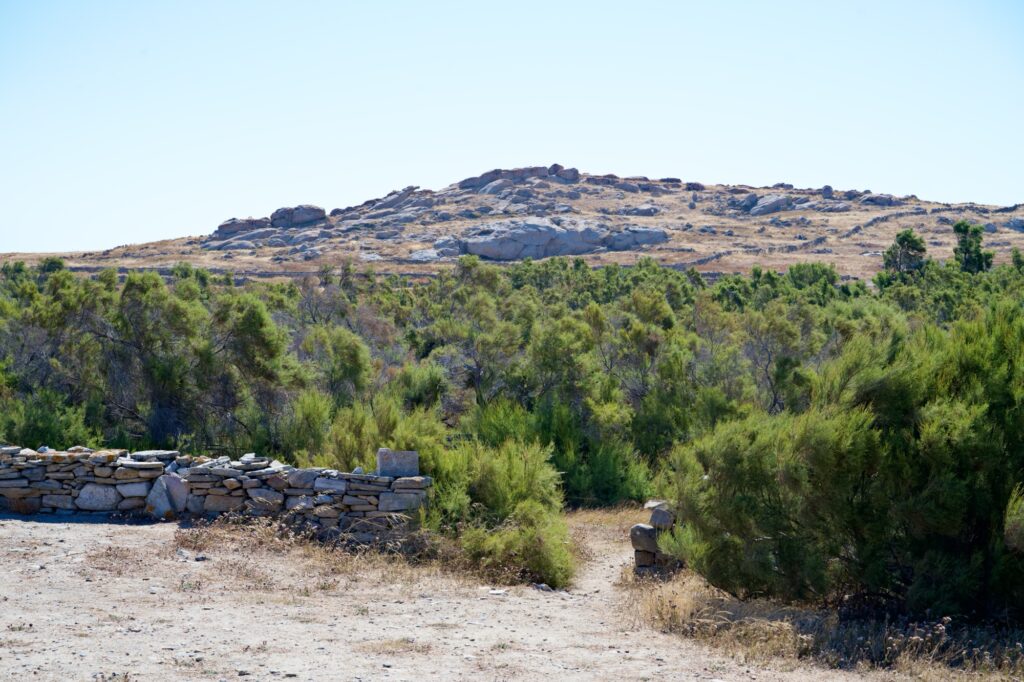
Today this spot is full of green vegetation (one of the very few green spots on the island), but it is believed to have previously been a lake.
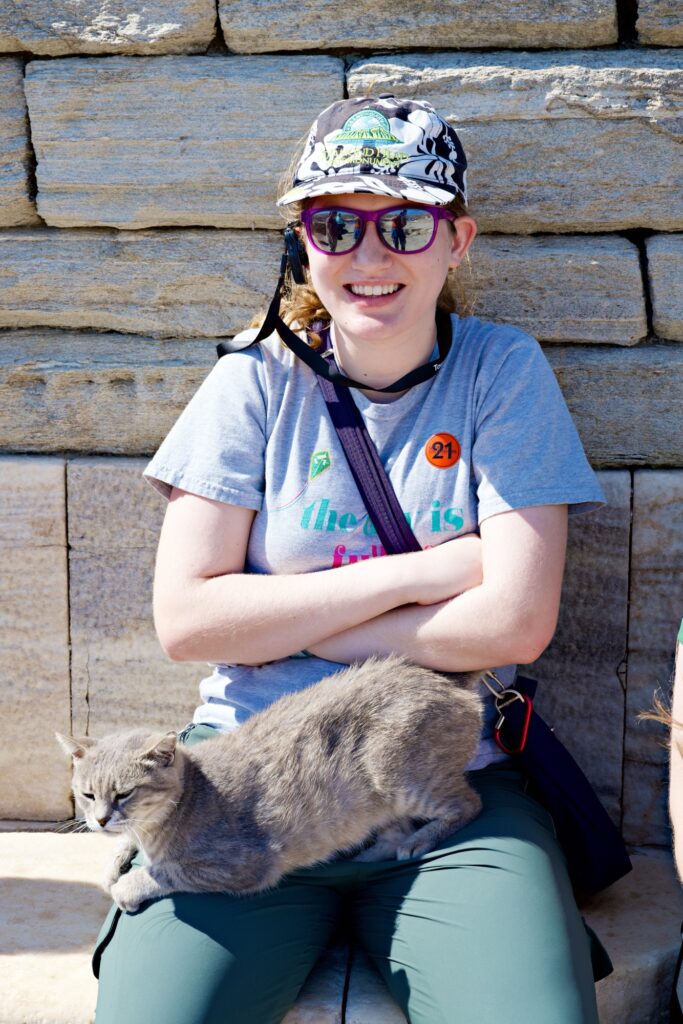
Most of the group was sitting while Sofia was telling us this. One of the cats on the island jumped on Sara, and Sara really does not like cats being on her (even though we have a cat – Luna). Previously Sofia told us that the cats on the island were gentle and like to be snuggled. As soon as this grey cat jumped on Sara, she said something like, “I know what I said about cats earlier, but be careful with that one. It is kind of bipolar”. Olivia tried to pickup the cat, but it kept digging its claws into Sara’s pants. Fortunately, it jumped off on its own after a couple of minutes.
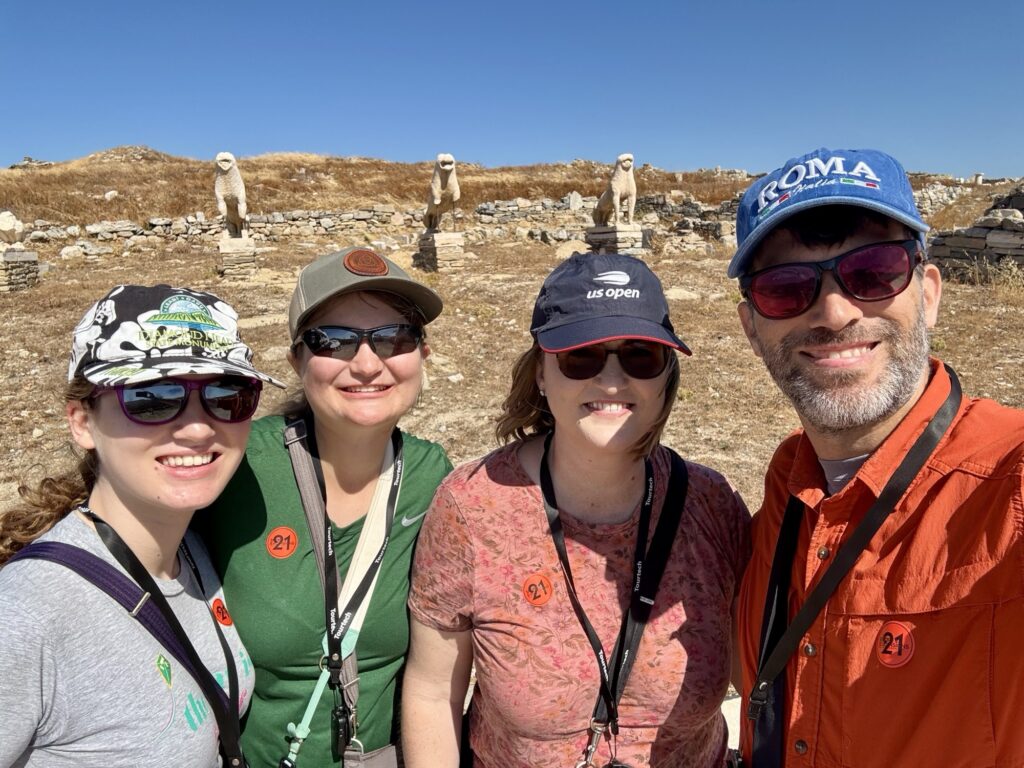
Anyway, there are six total lions remaining from the original 16. Five of these are on Delos and one is in Venice.
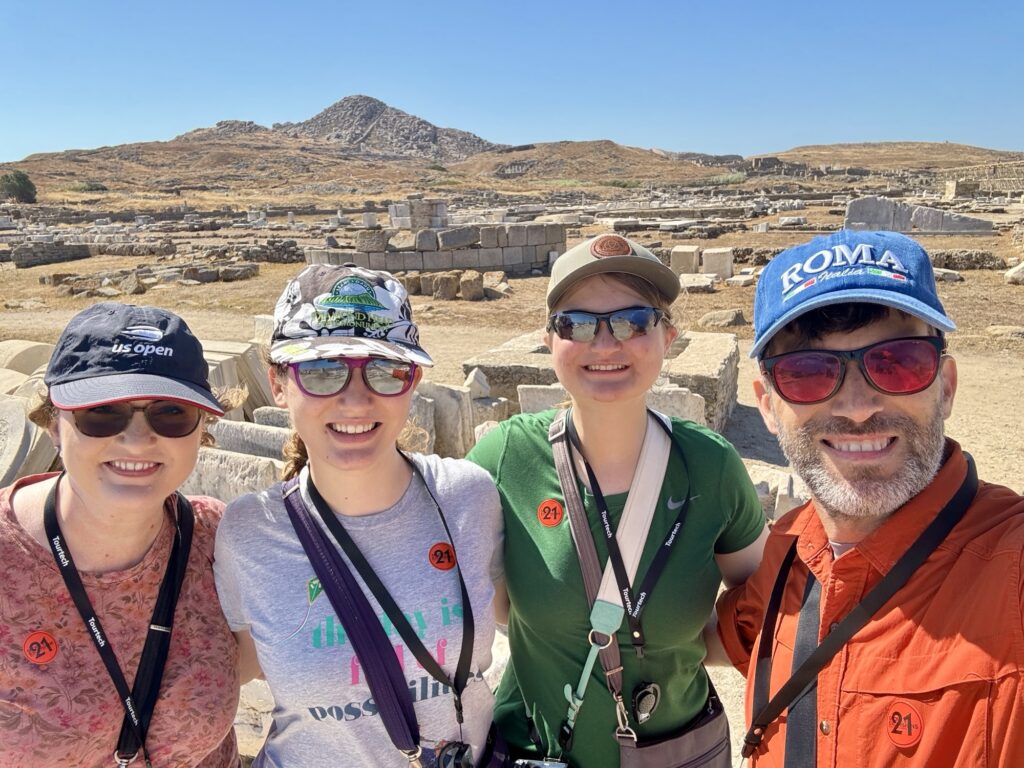
While telling us about the lions, Sofia also told us about the destruction of Delos from multiple pirate attacks in the late first century AD leading to Delos even being abandoned.
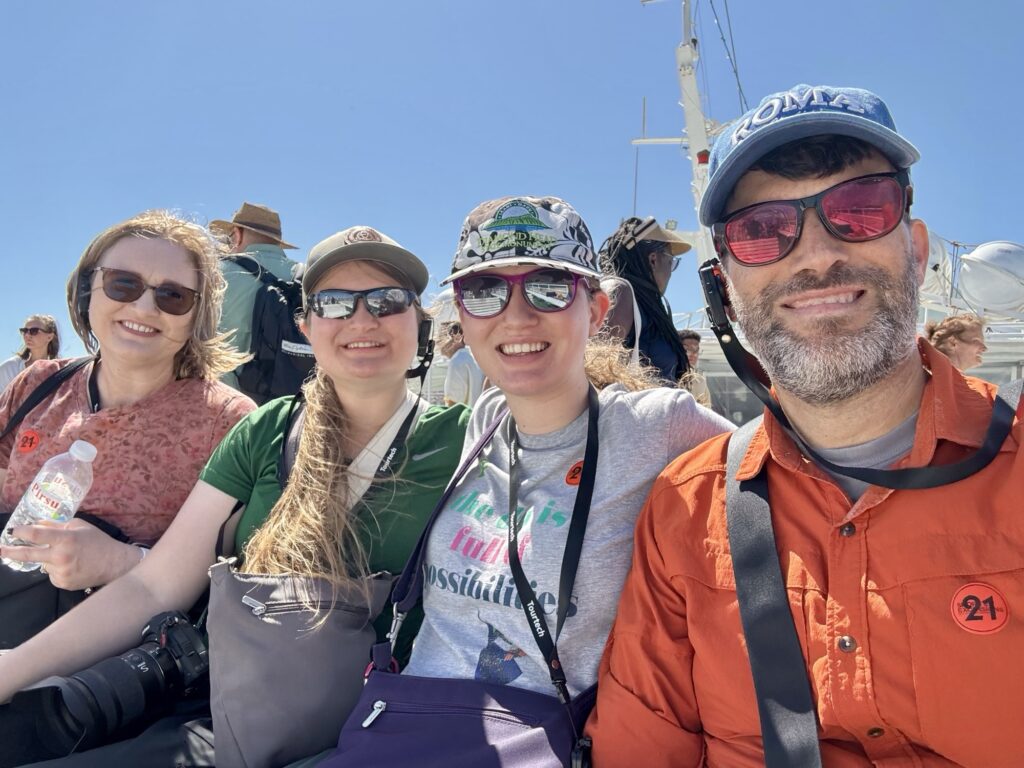
Sofia gave us about 45 minutes to walk around the site on our own before boarding the ferry boat back to Mykonos. This time our boat was the Orca. We started out on top, but they made everybody come inside because the sea was so rough. It was one of the bumpiest boat rides I’ve ever been on, but fortunately none of us got sick.
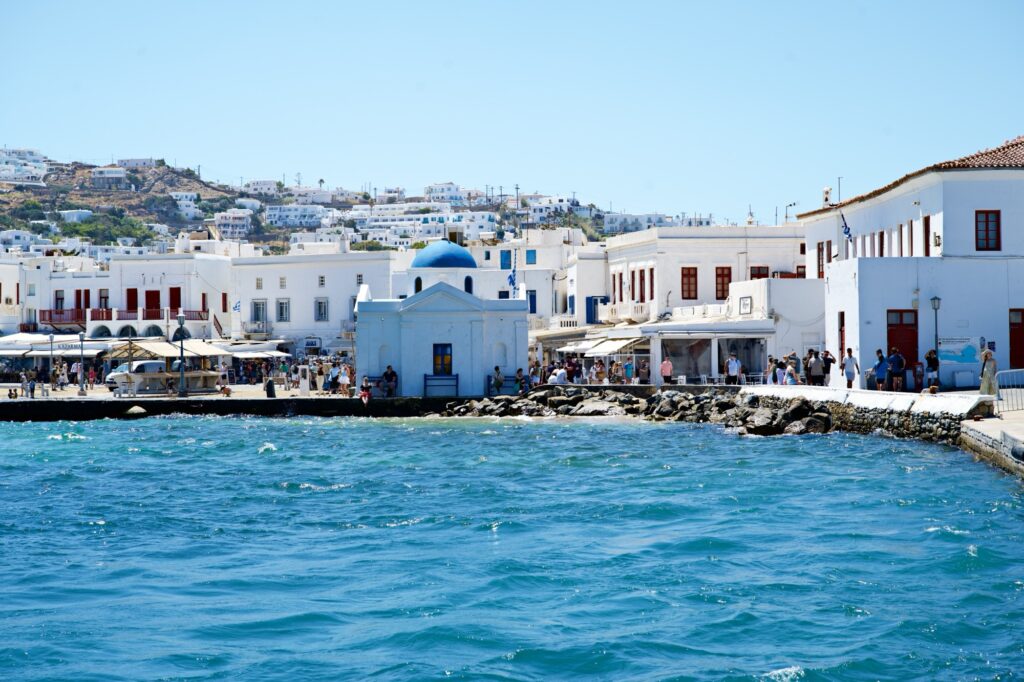
Instead of taking us back to the cruise port, the boat took us to Mykonos Town for a walking tour. As we began our walk through the beautiful white streets and buildings, Sofia told us that Mykonos Town has 10,000 permanent residents, but this number doubles in the summer months with people coming in to work and lead tours during the busy season.
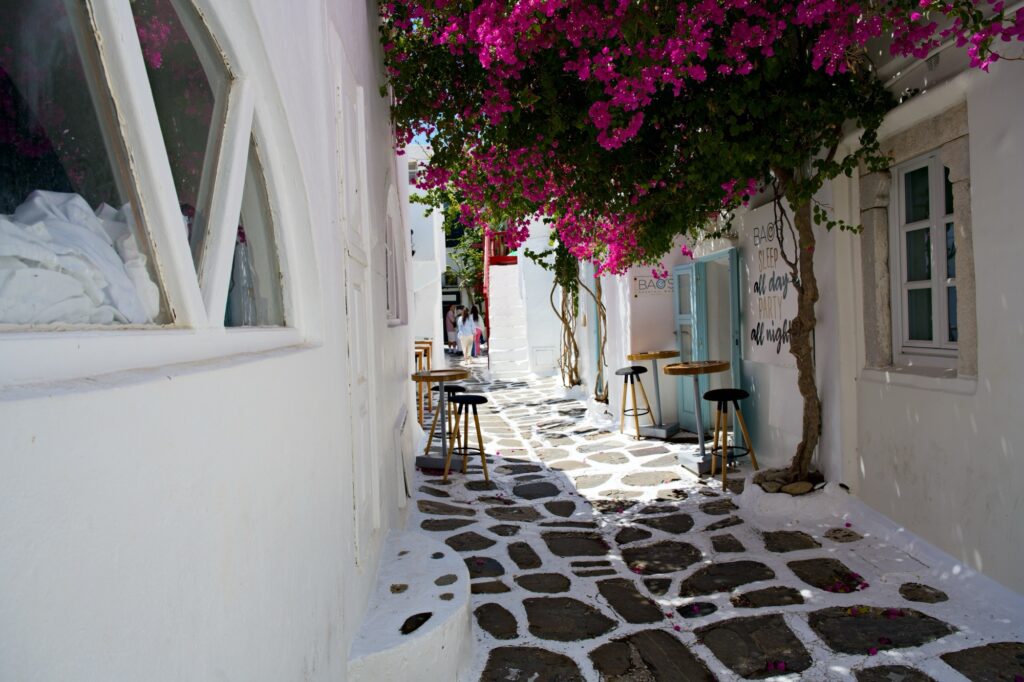
She said that everything in Mykonos Town is built of the dry granite stone like we saw on Delos. Originally, the buildings were left their natural grey color to camouflage them from pirates. This town was mostly fisherman in the past, and they built the maze like streets to confuse potential invaders. I’ll have to admit, I’m really good with directions and getting my bearings, but I don’t think I could have retraced our steps today. Walking through those streets was crazy.
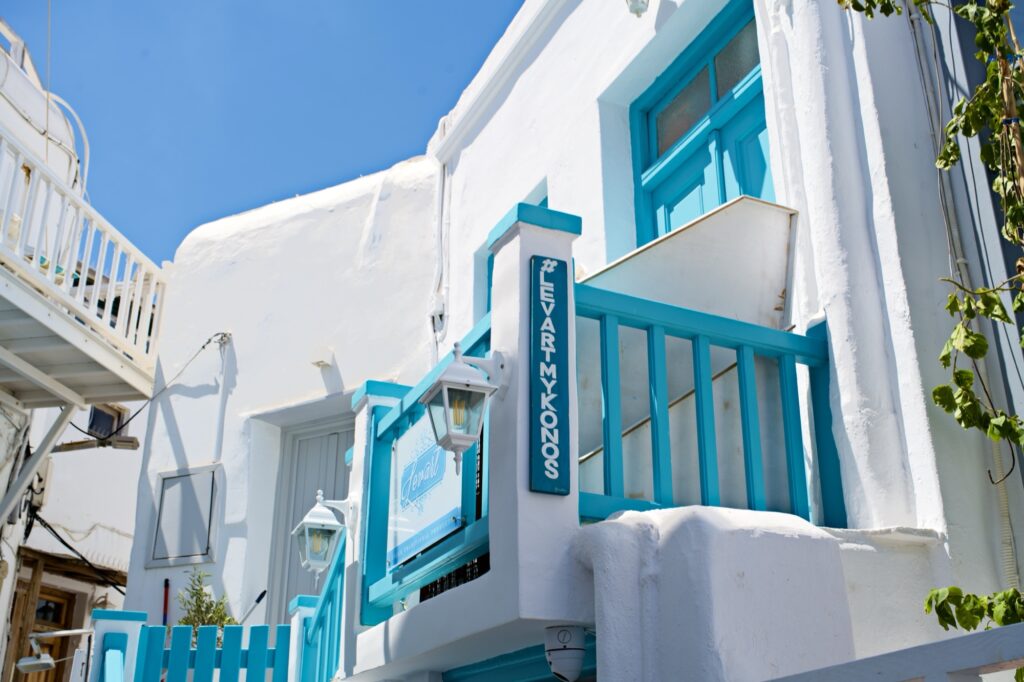
The white was added in the 1920s due to heat and to disinfect the buildings. The white paint was made with limestone, water, and white paint. Because o the antiseptic properties of lime, it was thought this would protect from plagues. Sofia pointed out that everything was painted white, including the buildings, streets, and even parts of the trees.
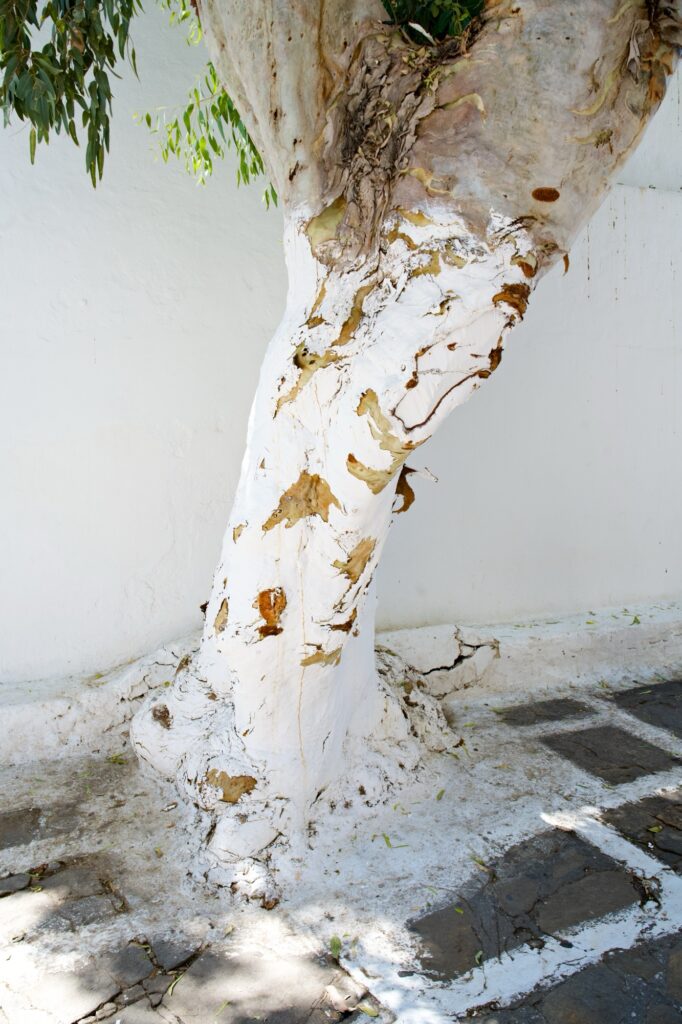
Buildings built today must follow strict regulations, that includes being a perfect cube, painted white, and not to exceed two stories. Most modern buildings are painted using standard white paint, but the churches still use the traditional mix only by churches. All of the roofs in Mykonos Town are flat, which was originally to collect rainwater. Today many of these are covered in solar panels.
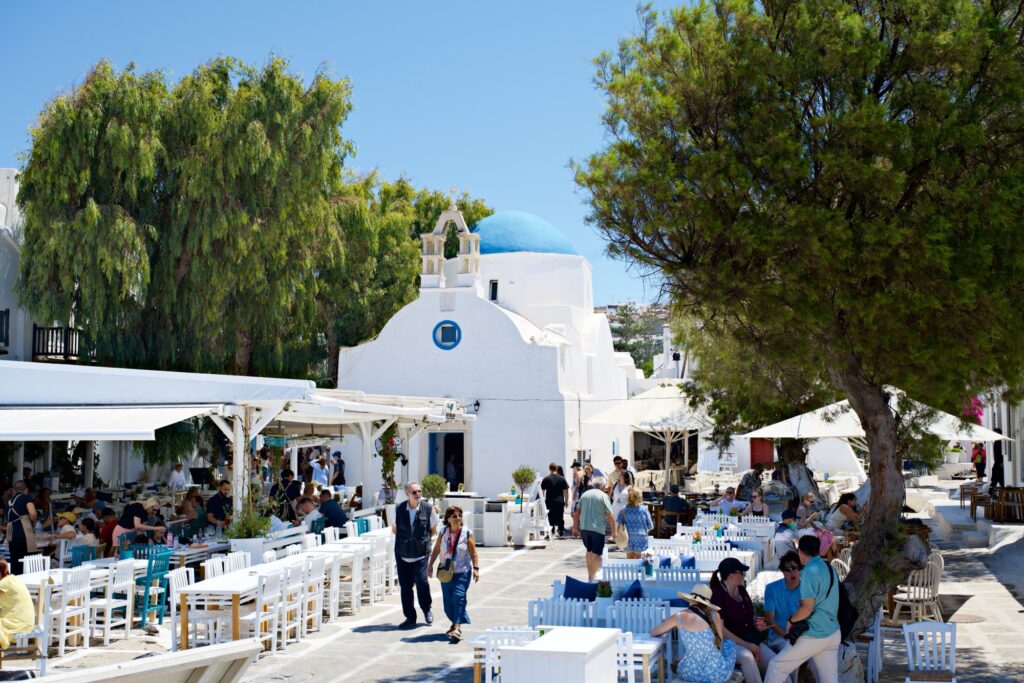
We slowly wound our way through the crowded streets to the Heart of Mykonos, where we saw the only Catholic Church building in Mykonos. In total there are approximately 800 church buildings on Mykonos Islands, and only one of these is not Greek Orthodox.
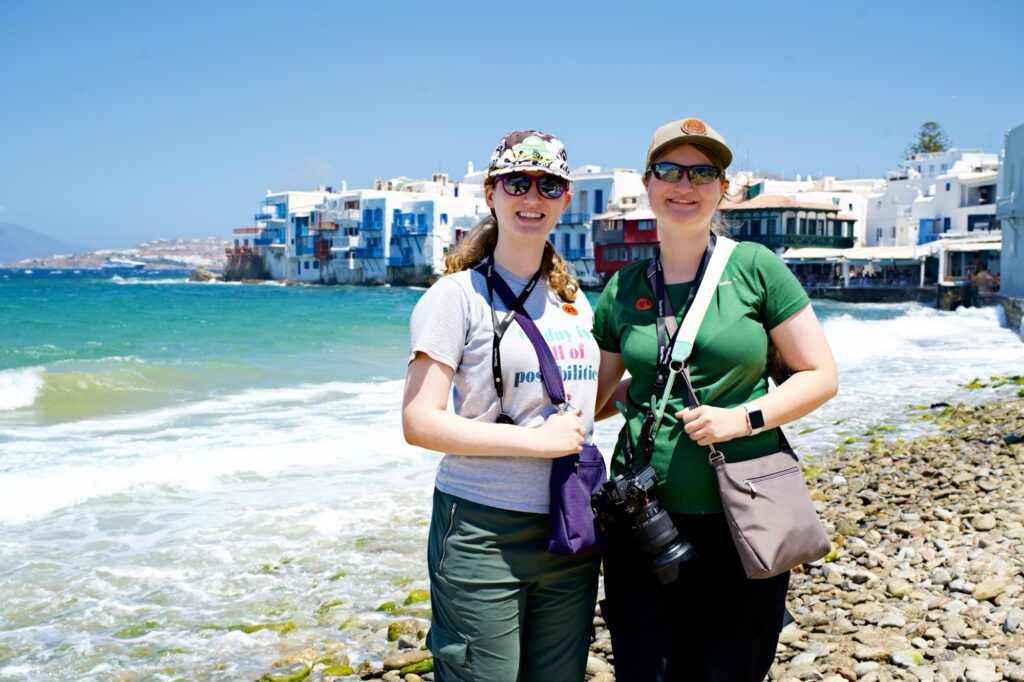
The Heart of Mykonos is on the sea, and this is area is know of a “Little Venice”. In the past this area was filled with houses for the upper class, wealthy merchants.
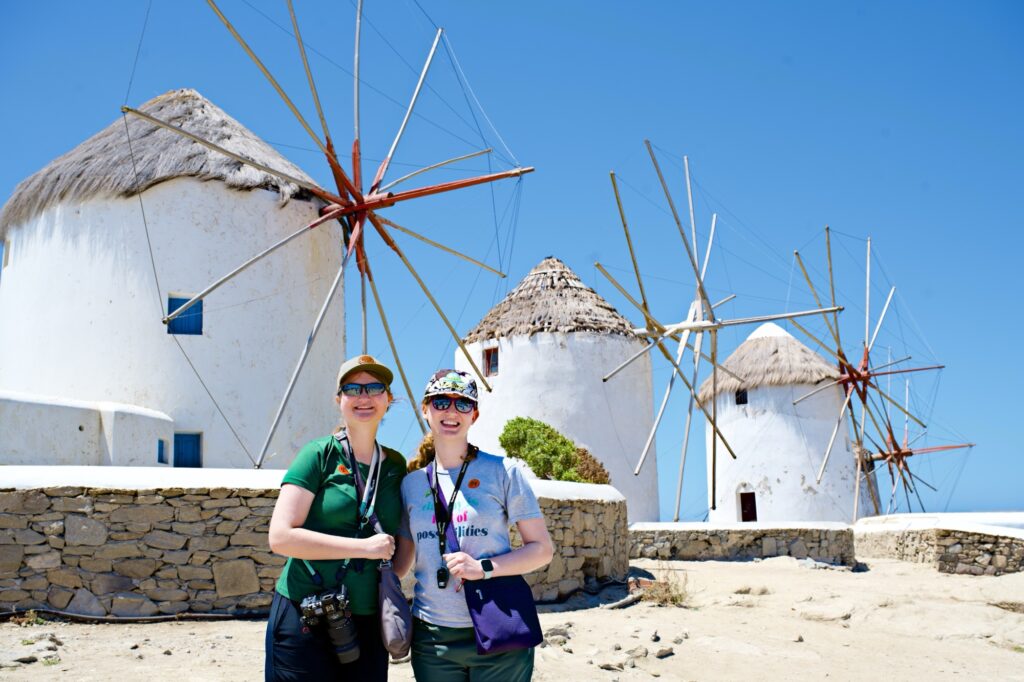
From this area we could also see several of the famous windmills. Sophia said that there are more than 600 windmills around the Aegean Sea. Originally these were for grinding grain, but they are no longer operational.
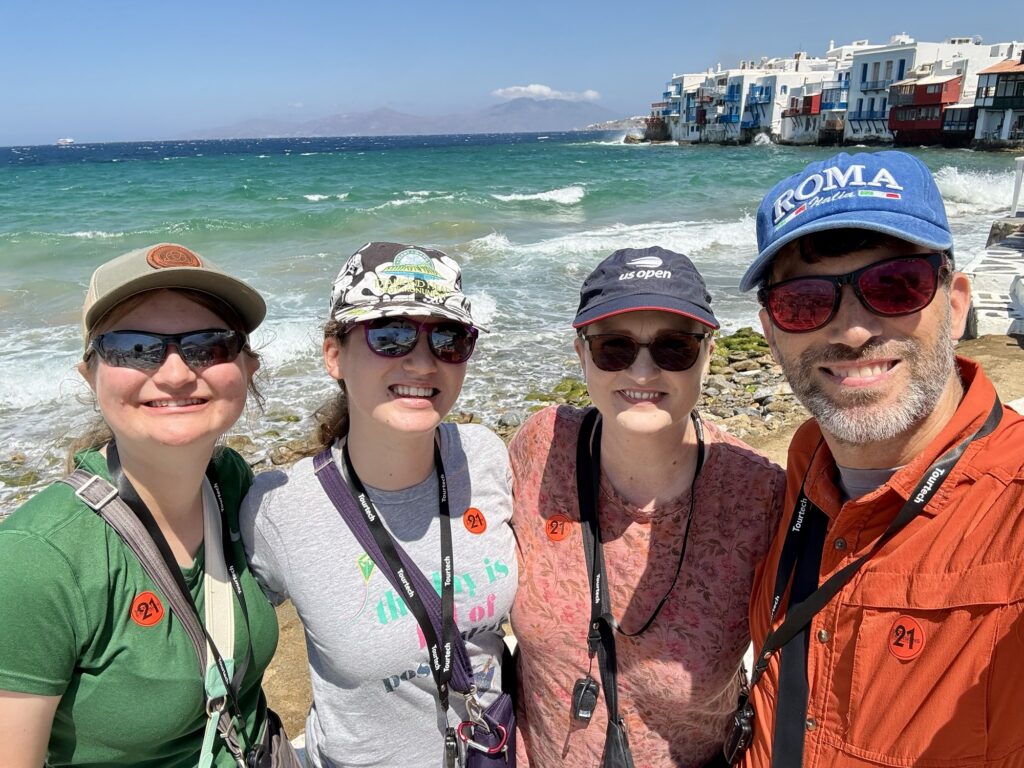
At this point, she gave us about 30 minutes of free time. We went up to look at the windmills and take some pictures. We also walked back down to the sea to snap some more photos and do a little shopping.
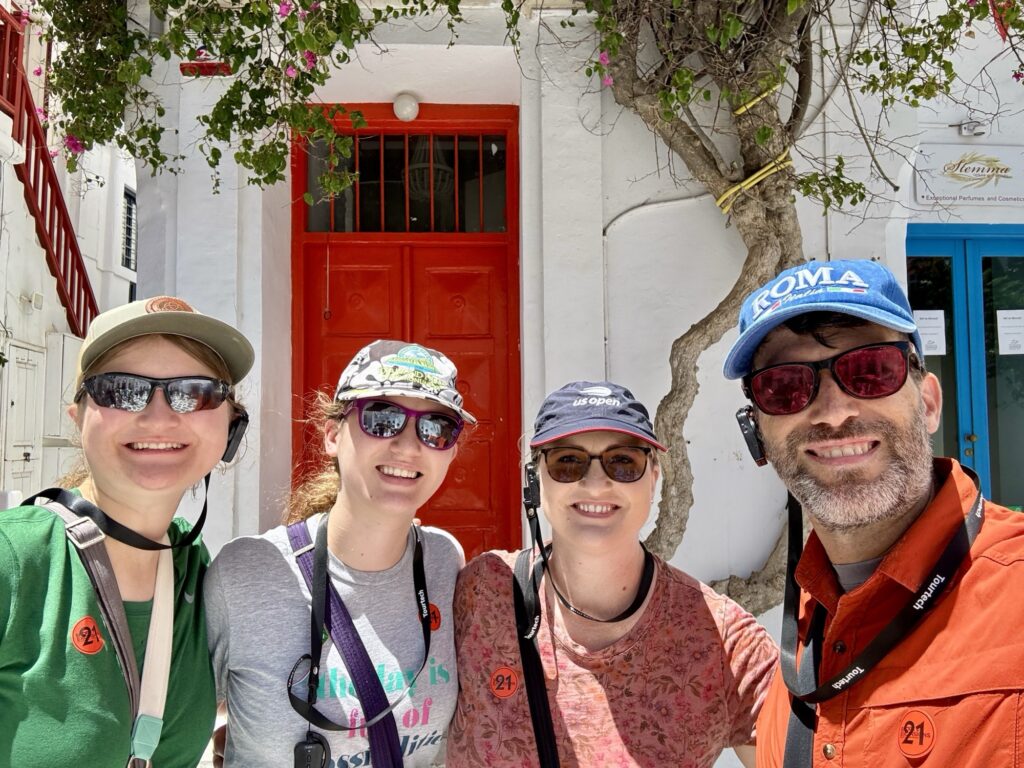
Once we met back up, we again began to walk through the streets of Mykonos Town toward the bus station. As we were walking, Sofia explained the image of the eye that we saw everywhere in Greece. This is known as the “Evil Eye”, but is actually for the warding off of evil. She said that many people in Greece have these by the doors of their homes.
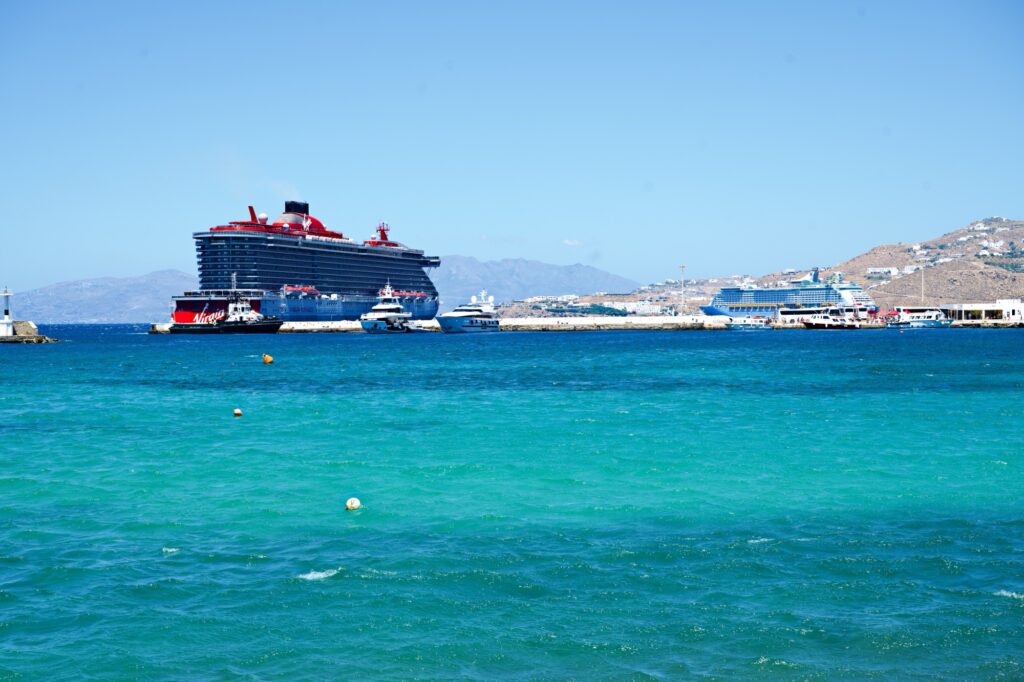
She also told us that the name Mykonos literally means “Island of the Wind”, and it certainly lived up to its billing today. There were several times when we had to catch our hats as they blew off our head.
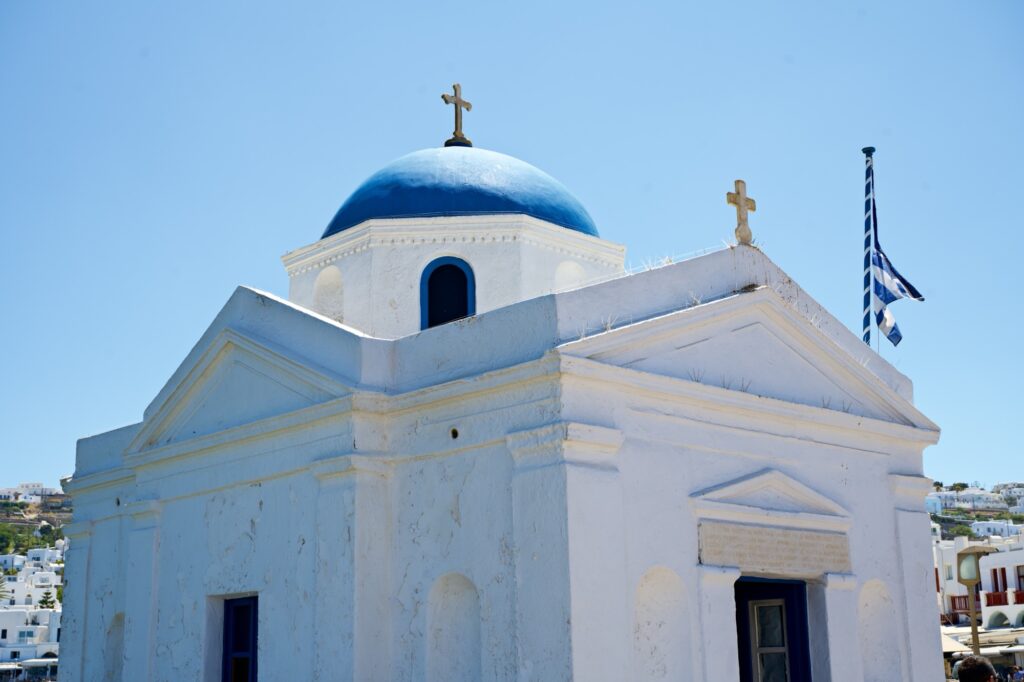
At the bus station, we boarded a coach for a drive up into the center of the island to Panagia Village for lunch. We saw lot of small Greek Orthodox church building along the way, and similar to Santorini, Sofia explained that most of these are family owned and only used for special occasions. She said that they would invite a local priest to come for these special occasions like religious holidays or weddings.
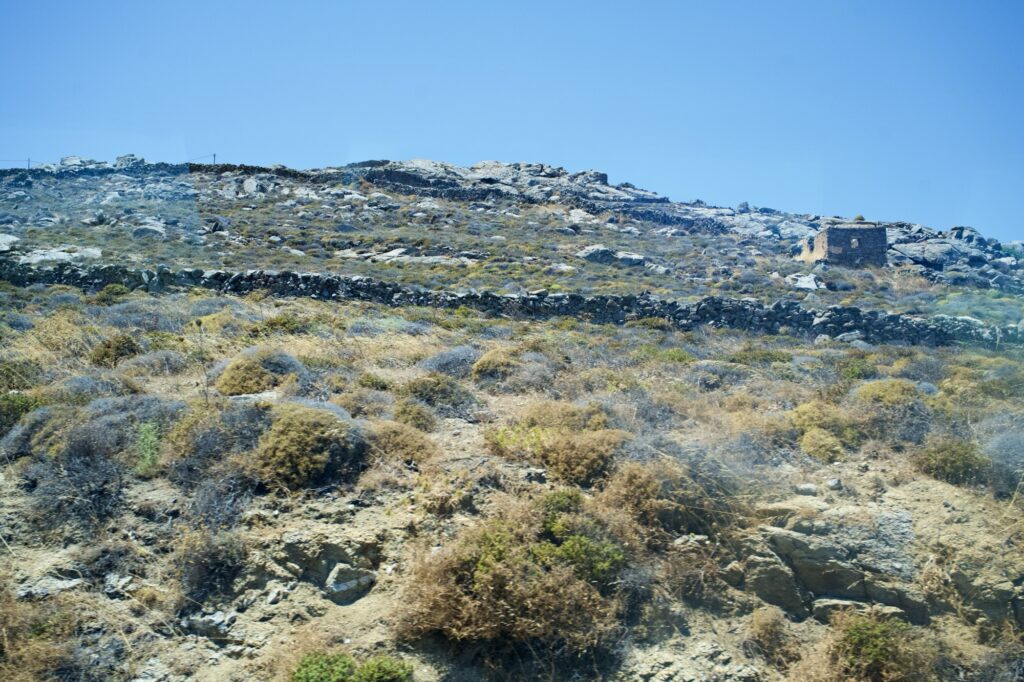
We could also see lots of natural granite formations in the hills that explains why everything in Mykonos is build of this dry stone. The stones were also dry stacked to create fences for the raising of animals.
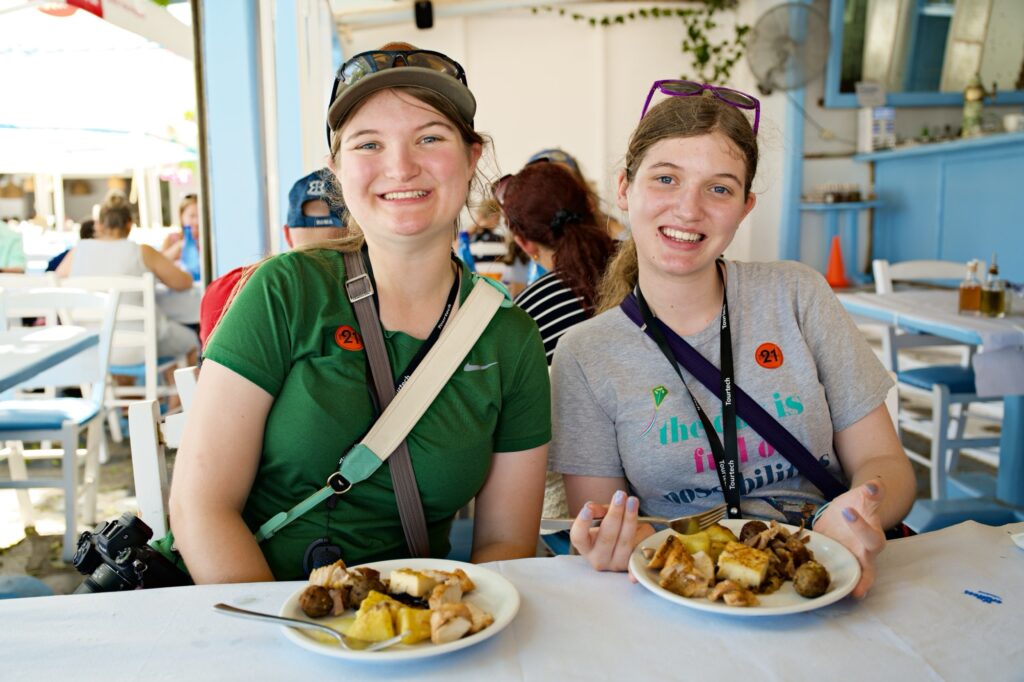
Upon arrival in Panagia Village, we walked to Taverna “Vangelis” for lunch. We started with a bread that have several different spreads including hummus and taziki sauce. We then shared a Greek salad followed by an entree that featured a sampling of Greek food featuring meats and potatoes.
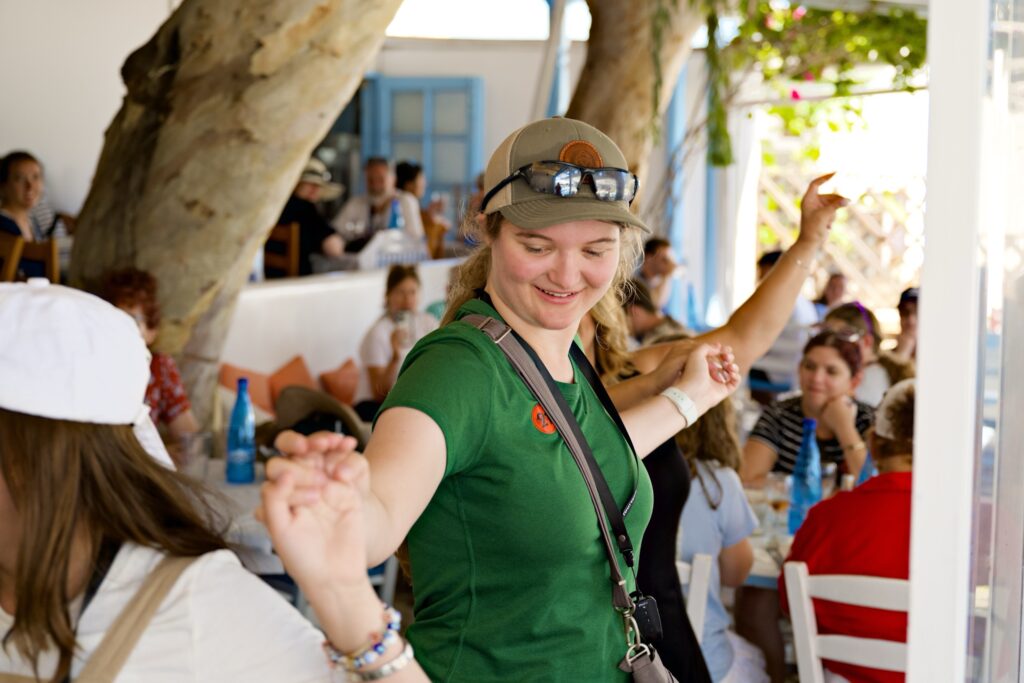
During lunch, there were Greek dancers who were showing us several traditional Greek dances. Kate even joined them for a bit, which was pretty cool, and I loved her smile and laugh as she was dancing.
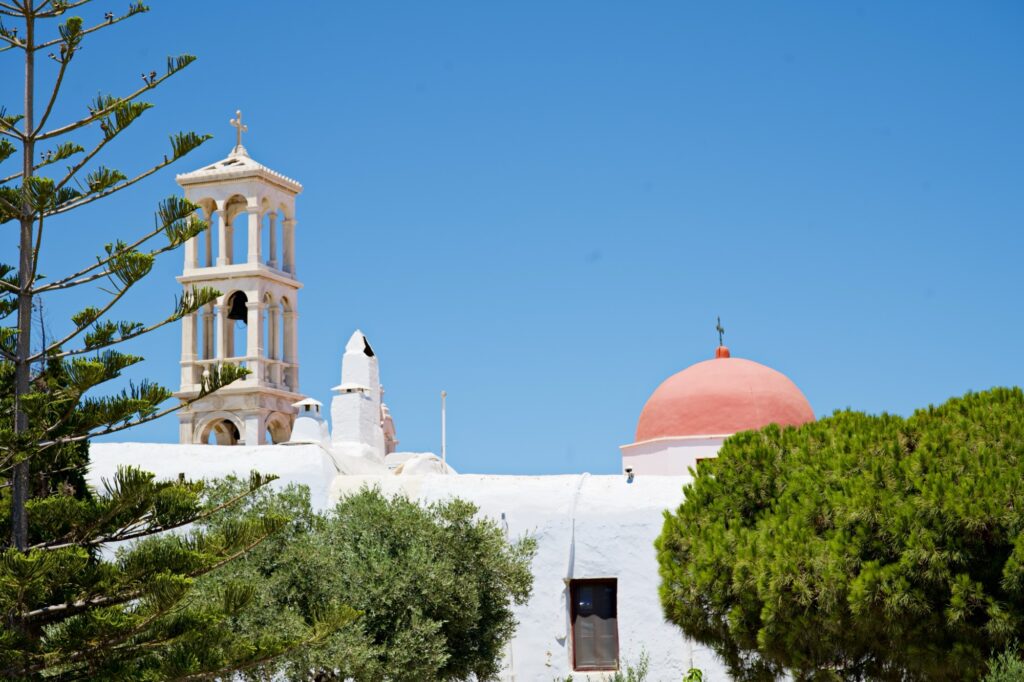
After lunch, we made the short walk over to the Panagia Tourliani Monastery, which originally dates back to the 16th century AD. Outside it has a bell tower and a beautiful red dome.

As we walked inside, Sofia said that the facade was updated through 1767 to the building that it is today.
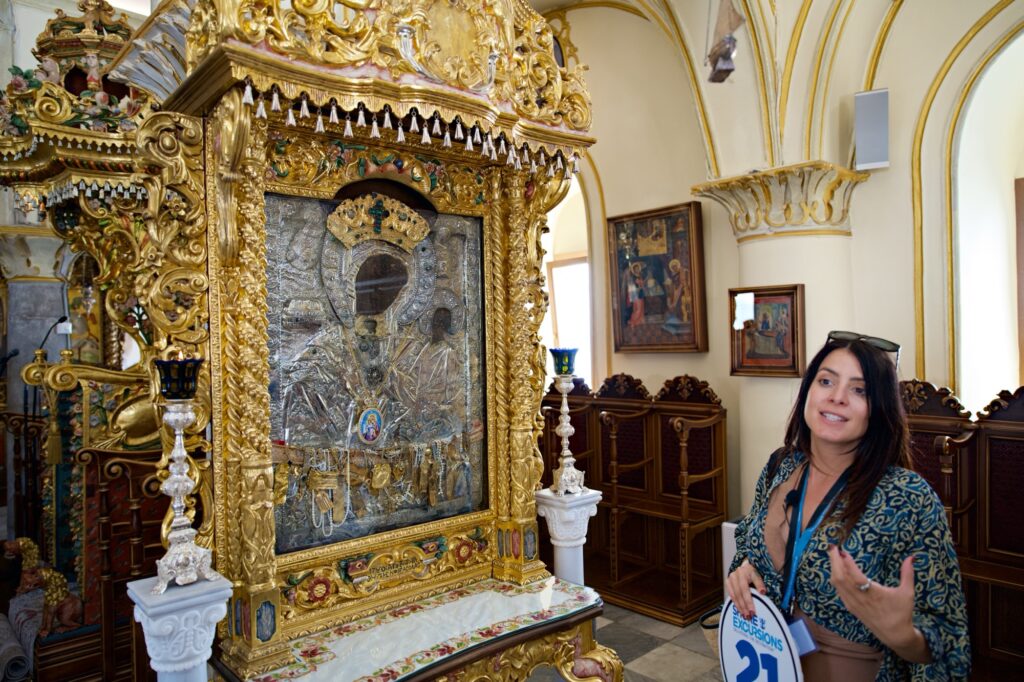
Inside she showed us several icons, which are present in Greek Orthodox church buildings instead of statues. She said that one would approach the icon and make the sign of the cross, kiss the icon, and then offer a prayer.
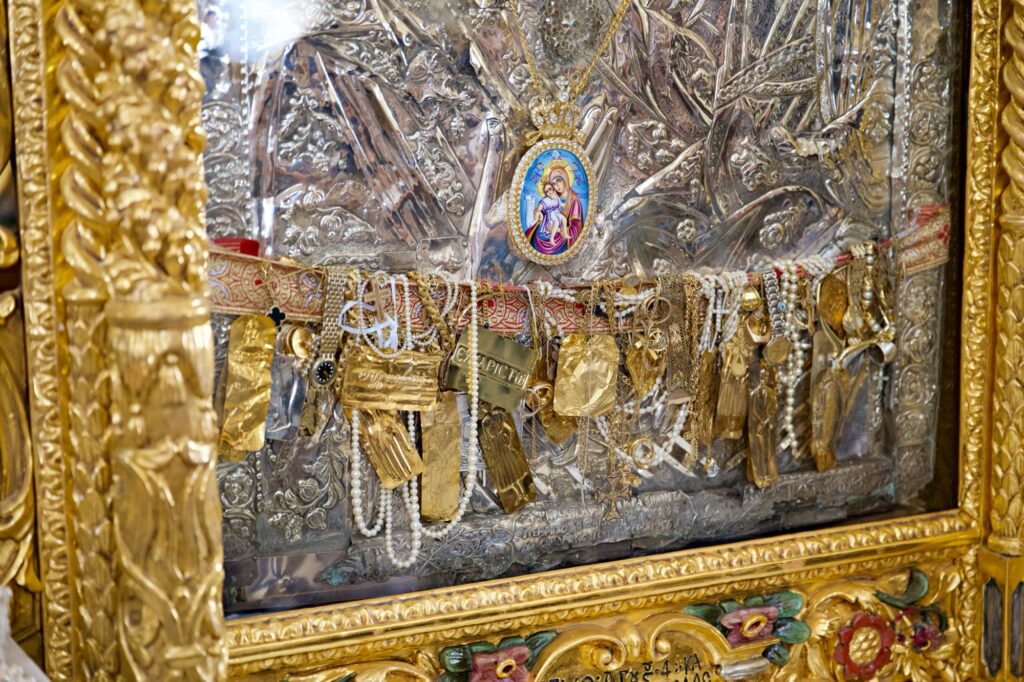
If the prayer was answered, then some will come back and make a thank you offering to the icon of something valuable to them. We could see several objects hanging in front of the first icon that we observed.

In the dome, there was a beautiful fresco painting of Jesus giving a blessing in the Greek style. At the base of the dome, Jesus was surrounded by the twelve apostles. Sofia explained that in Greek Orthodox worship there are no musical instruments, but the services consist of chanting.
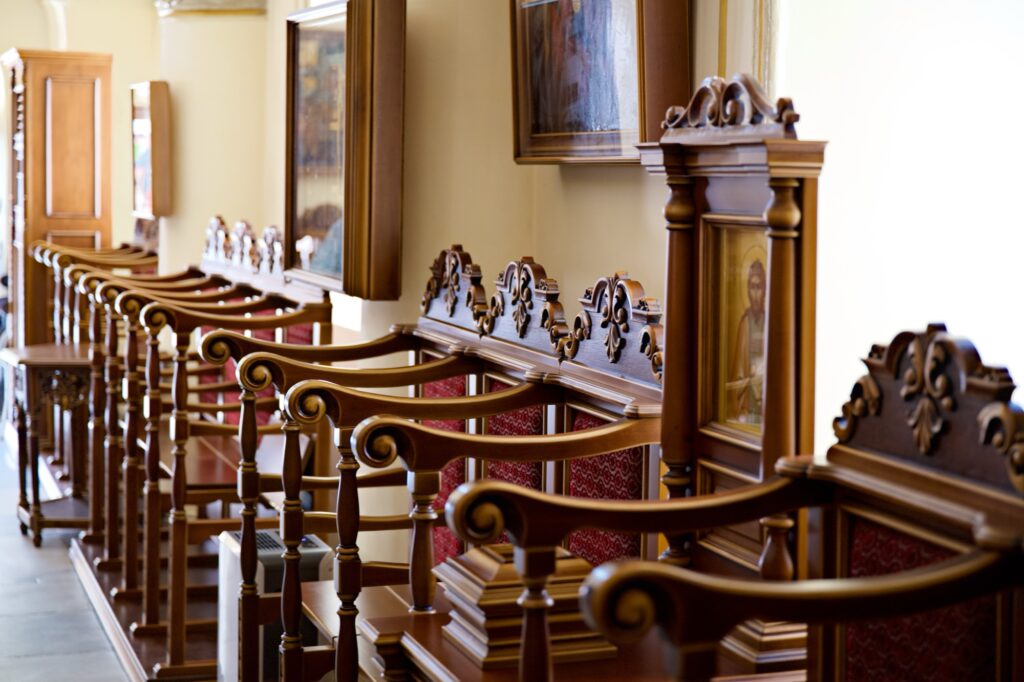
Also, there are no benches or pews in a Greek Orthodox building because they use individual chairs for each worshiper.
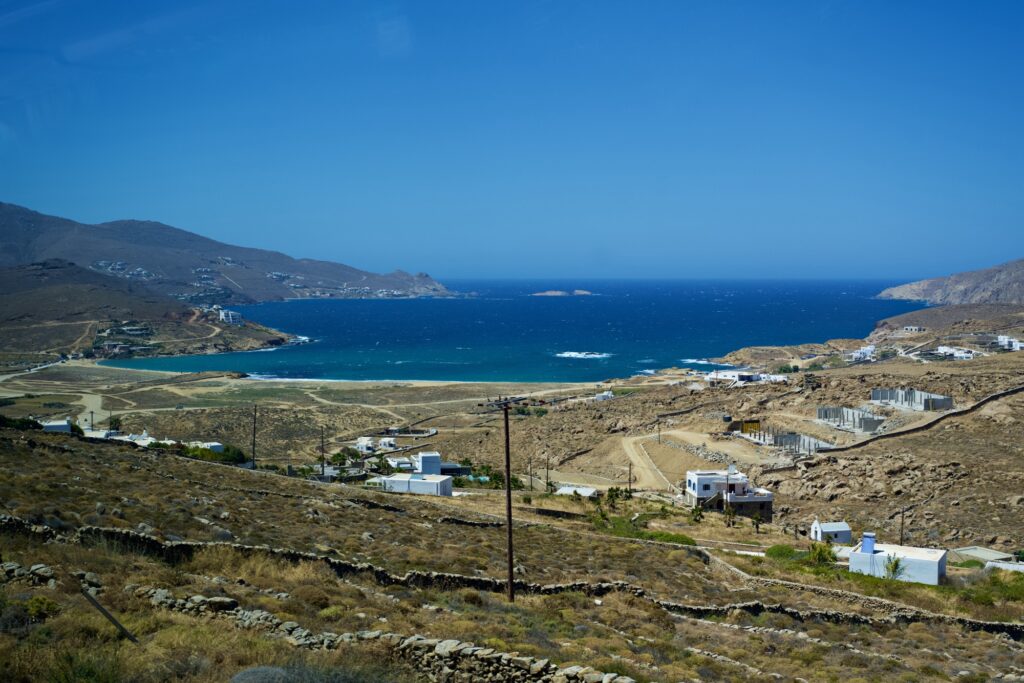
Once we were back on board the bus, we made our way back to the port and said goodbye to Sofia. Back on the Voyager of the Seas, we headed back to the room to cleanup, pack, and then had a family worship service in our cabin. We sang several hymns and read from Luke’s account of the crucifixion and resurrection.
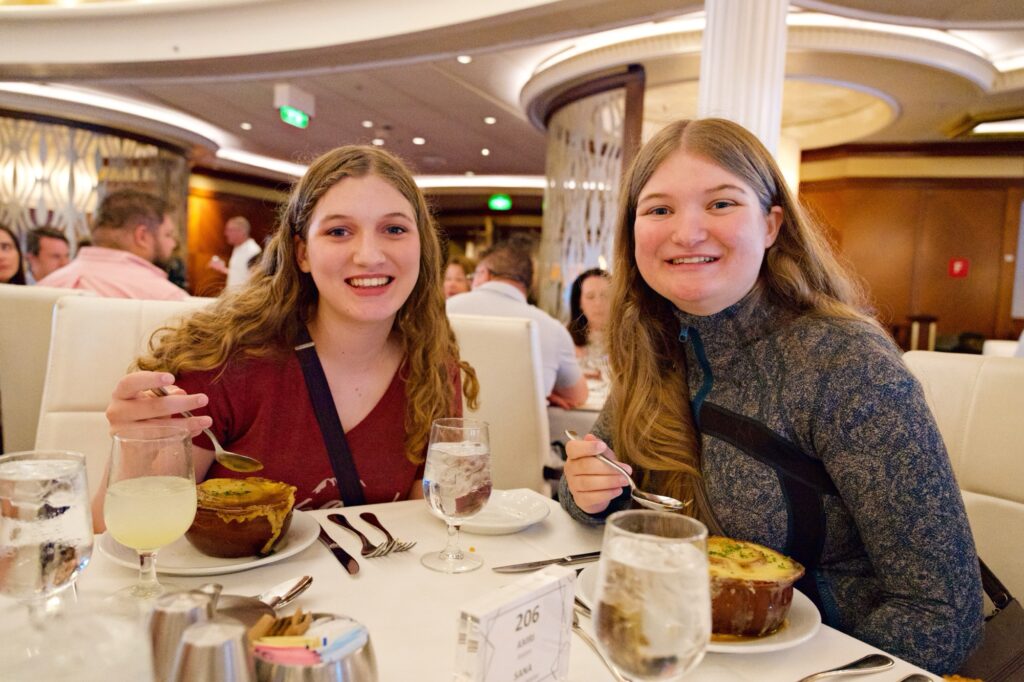
After our worship service, we headed down to the Main Dining Room for our final dinner aboard the Voyager of the Seas. We were again seated with Amri and Sana, who have been wonderful to us all week.
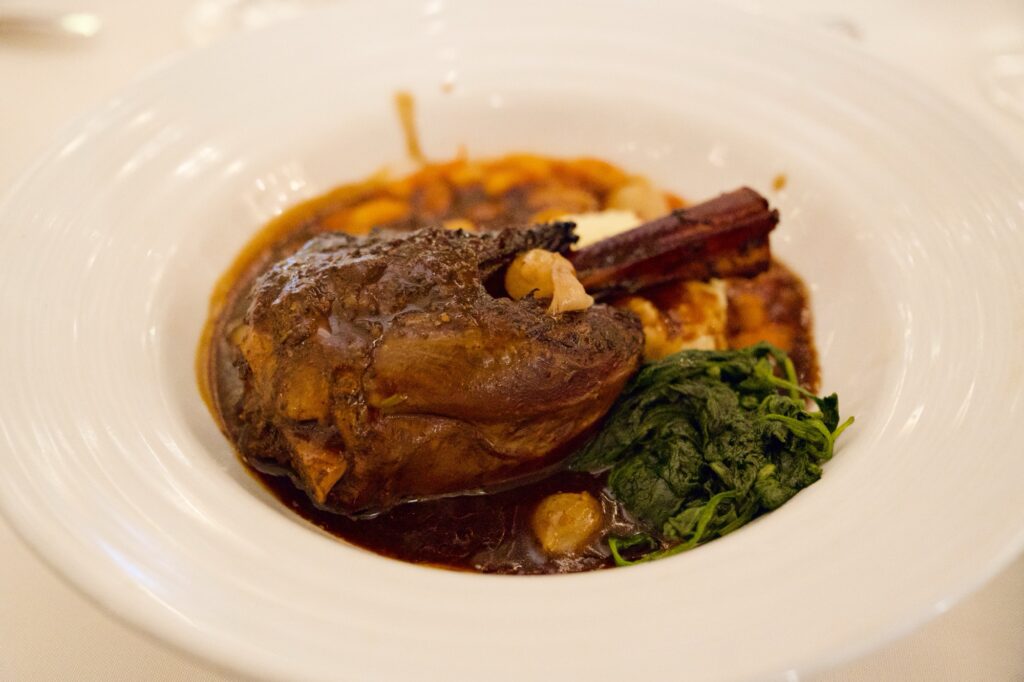
For dinner, I had a caesar salad, braised lamb, and a chocolate brownie for dessert. The braised lamb was the best entree I had in the Main Dining Room all week.
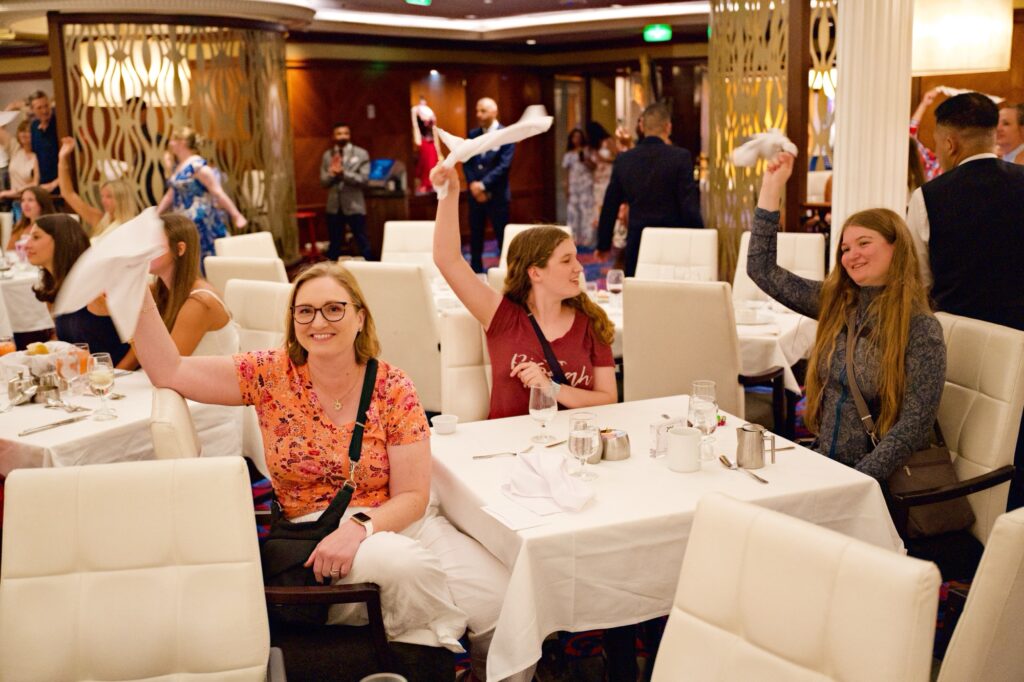
As dinner was winding down, all of the Main Dining Room staff did a parade around the tables as we waved our napkins, and then they did a dance on the main staircase. It was really thing that happens at the end of most cruises we have been on.
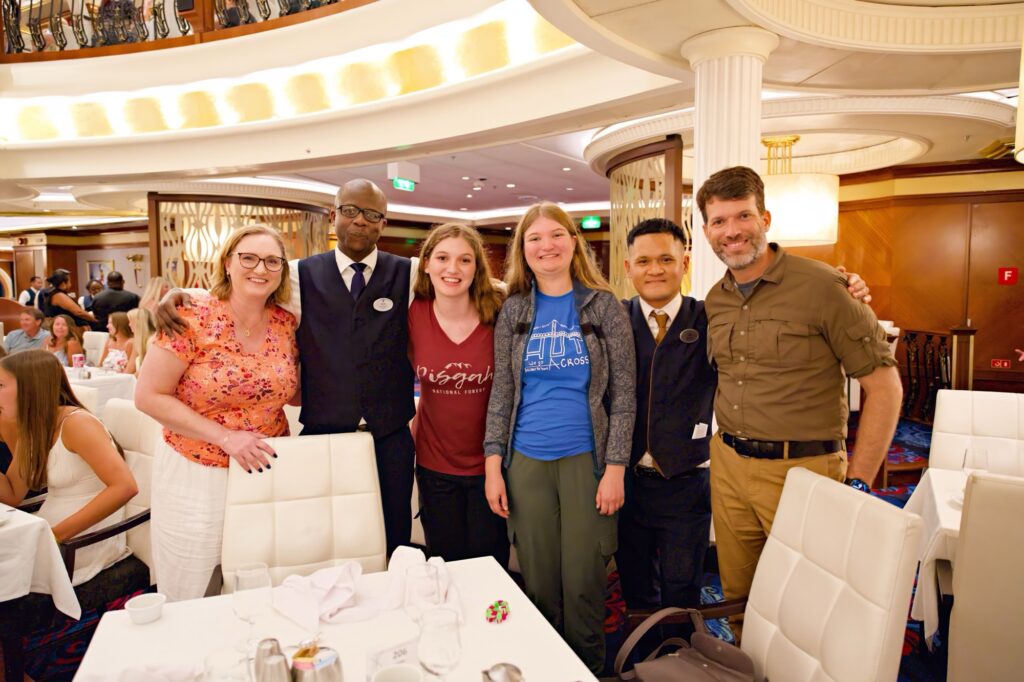
The head of the Main Dining Room announced that the staff consisted of 253 servers from 34 different countries. After the parade and dance, we said our final goodbyes to Amri and Sana, who gave us all hugs, and took a picture together!
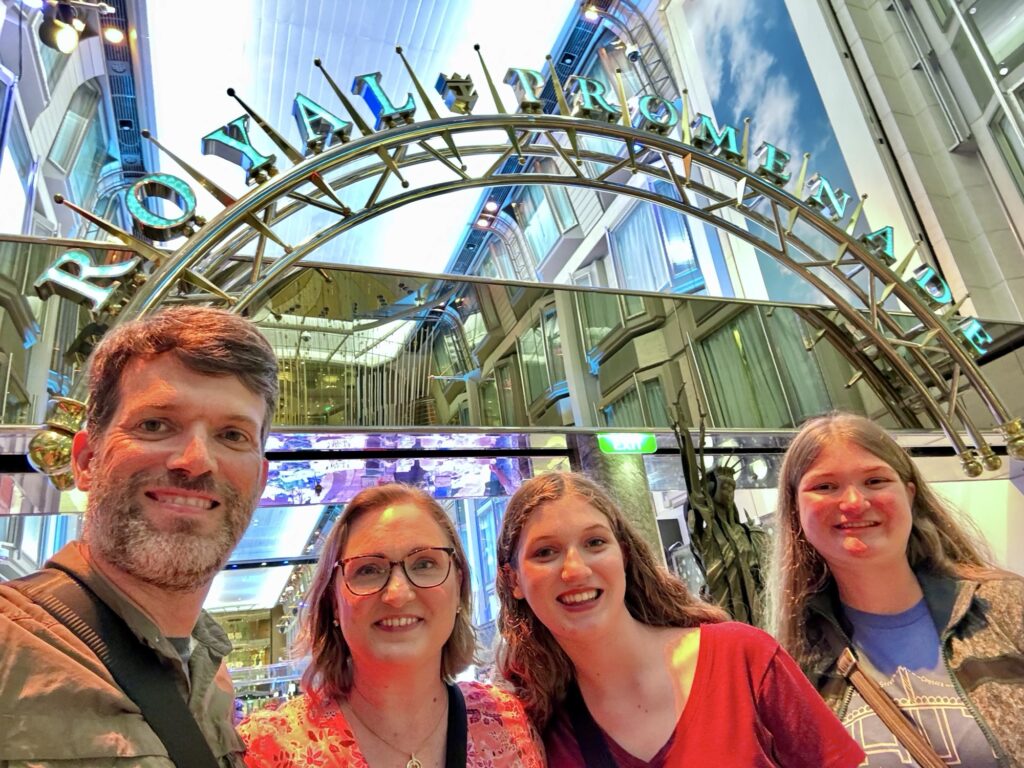
Finally, we made our way back to our stateroom to pack a little more and turn in for the night. Tomorrow we disembark and spend two more nights in Athens.
